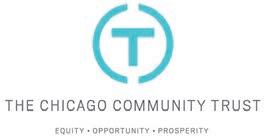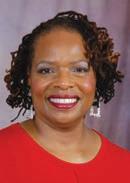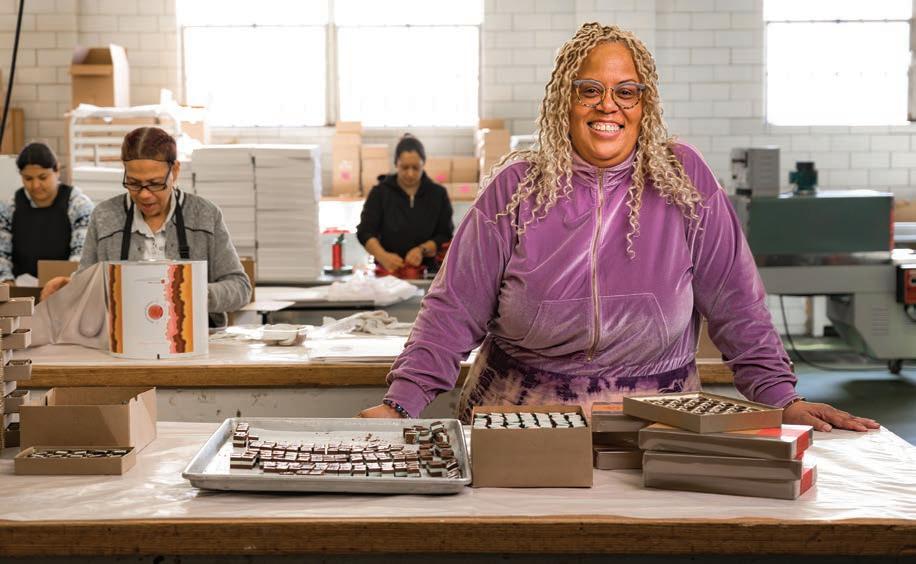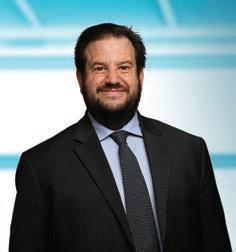






The south suburbs may be the epicenter of Cook County’s rising property tax burden, but with so many government entities, it will be hard to nd a single solution that satis es everyone I PAGE 15


Black and Latino restaurant owners in Chicago are learning how to survive and thrive in an eat-or-be-eaten business transformed by the COVID pandemic I PAGE 11

Sizing up a startup? Check

e corporate world has its own unique rules, language, and rituals. Mastering these subtleties is crucial for navigating and thriving in this environment while staying true to your authentic self, voice, and values.
In October, Crain’s featured the initial installments of Part 2 in my series, "50 Career Insights for Gen Z and Millennials." is column delved into strategies for thriving within organizational landscapes — an often unfamiliar and daunting terrain for many young professionals.
Now, I’m excited to share three new, critical insights that are essential for anyone starting their journey in the corporate world.
You won’t change a corporation

Michael Fassnacht is former CEO of World Business Chicago and is now chief growth o cer at Clayco in Chicago.
In my experience, creating
meaningful change within any organization is an incredibly difficult and challenging endeavor, regardless of one's position, even as a CEO. Every organization has a unique origin story, intrinsic values, ingrained behavioral patterns, and spoken and unspoken norms. These elements, combined with organizational muscle memory and other factors, create inherent resistance to change.
There are two crucial caveats: The higher one's position, the more power they have to instigate change, and the larger the organization, the more daunting the task becomes. I do not suggest that young profes-
sionals remain passive in the face of unprofessional or disrespectful behavior. It is just that they should speak up with full recognition of the constraints on their ability to effect genuine change within the organization.
Your well-being is up to you
For many young professionals, the pressure to perform well and the desire to be positively perceived by peers and superiors are paramount. This concern is natural in any business environment, especially in the early stages of one's career. However, the pursuit of professional success should not come at the expense of emotional well-being. Relentlessly chasing status can lead to unproductive stress and self-doubt, undermining your emotional health.
From my own experiences, I've learned the importance of protecting your emotional well-being from the influence of the company and its leadership.
While dedication and excellence in work are admirable, it's crucial to ensure that personal happiness and emotional health remain independent of the corporate environment. Achieving this balance can be challenging, but continuously reminding yourself of this "emotional independence" is critical to achieving balance, happiness, and ultimately, greater success.
Don’t let a job keep you up at night
Early in my career, I didn’t just face a few stressful weeks — I found myself stuck in a cycle of sleepless nights, with only brief moments of emotional balance. This experience led me to adopt a simple yet profound rule: If my job causes me to lose sleep for more than five consecutive nights, it’s time to seriously consider leaving. Over the past 25 years, I've stuck to this principle, and it has proven invaluable in helping me maintain emo-
tional balance even in the most challenging professional circumstances.
I can’t emphasize this enough. Prolonged sleep loss due to work-related stress is a clear signal that something is deeply wrong — a red flag that shouldn’t be ignored. It’s often not about placing blame on either the employer or oneself but recognizing that the combination of factors has created an unhealthy dynamic.
Entering the corporate world can feel intimidating, particularly in the early stages of one’s career. However, developing a mindset that blends curiosity with discernment is essential for long-term success.
Like any domain, the corporate world has its own unique rules, language, and rituals. Mastering these subtleties is crucial for navigating and thriving in this environment while staying true to your authentic self, voice, and values.
There were 51,984 fans packed into Comiskey Park to see the White Sox sweep a Bat Day doubleheader from the still despised Yankees on June 4, 1972.
And over the years I’ve probably run into 250,000 folks who say they were there.

Credit the Dick Allen Effect. He was an electrifying presence on a baseball eld; no one went to the beer stand when No. 15 was scheduled to hit. And though his tenure here was brief — three seasons, 348 games — the things he did with that 40-ounce war club in his hands are so vividly recalled that they must have been witnessed rsthand.
Bat Day 1972 is a classic example. e largest Comiskey Park crowd in 18 years had been treated to a tidy 6-1 Sox victory in Game 1. Tom Bradley went the distance for his sixth win, the late Bill Melton hit a home run, and Carlos May and Mike Andrews drove in two runs apiece. Allen was 2-for-4 with a double.
Allen had played in each of the team’s 41 games to that point, so manager Chuck Tanner told him to take a break and skip Game 2 “unless we need you.”
Sure enough, the Sox trailed 4-2 in the ninth inning when Tanner sent a batboy to the clubhouse to “ask Dick if he wants to hit.”
“Chili Dog MVP” authors David Fletcher and John Owens have Allen sitting down to a Sunday dinner of chili dogs when the batboy arrived. A cold beer on a warm day might have been on the menu as well.
“Who’s pitching?” he asked the kid.
“Sparky Lyle.”
“Tell Chuck I’ll be right out.”
Melton had walked and Andrews had singled, so Allen came to the plate as the potential winning run when he was announced as a pinch-hitter for shortstop Rich Morales. Allen’s subsequent departure from the Sox would be acrimonious. He simply left and went home in September 1974, citing general disillusionment, and missed out on 34 games total that season. He had no relationship with the team thereafter, until the Sox extended an olive branch by inviting him back in 2012 to acknowledge the 40th anniversary of his MVP season, one that might have saved baseball on the South Side.
Allen’s memory of June 4 was as sharp as those 250,000 eyewitnesses’.
“With Sparky Lyle, you knew you were going to get a slider,” he told me. “At 1-and-1 he threw me one, and I hit it out of the ballpark.”
Allen’s eyes gleamed as he recounted the moment. e reaction was felt from Bridgeport to Belvidere to Bourbonnais.
e Sox would hang around in the division race for most of the season before the Oakland A’s pulled away, on their way to the rst of three straight World Series titles. A broken leg would limit Allen to 72 games in 1973, and his ba ing departure brought an abrupt end to a magical run in 1974.
But over those 348 games, Allen did things Sox fans had never seen before, providing them with memories they retain to this day.
“It’s about time,” was the bittersweet reaction to Sunday’s news that Allen, four years after his death, had been elevated to Hall of Fame status by a “modern era” Veterans Committee charged with checking
the work of the occasionally prissy voting members of the Baseball Writers' Association.
Dave Parker was also a bene ciary of the committee’s revisionist process. A physically imposing ve-tool wonder, Parker had been recognized as baseball’s best player for the better part of a decade before injuries and a center-stage role in the tawdry Pittsburgh drug trials took a jackhammer to his reputation.
But no one can deny the power and beauty of what Parker and Allen did on the eld.

Allen’s four-teams-in-four-years sojourn re ected a penchant for going his own way. at probably hurt him in the eyes of the writer/voters, who tend to prefer a more clean-cut model of hero.
“He didn’t have the numbers” also was frequently cited, in reference to Allen’s failure to approach 3,000 hits or 500 home runs, which all but guaranteed Hall of Fame stature until Rafael Palmeiro and Alex Rodriguez got there through chemistry.
Numbers known only to Bill James and his fellow seamheads 30


years ago — on base plus slugging, runs created, wins above replacement and etc. — are now widely accepted as a better measure of a player’s true value. And by that measure, Dick Allen holds his own with Henry Aaron, Willie McCovey, Billy Williams and the other Hall of Famers of his generation.
So he’s a Hall of Famer himself. And it is about time.
Crain’s contributor Dan McGrath is president of Leo High School in Chicago and a former Chicago Tribune sports editor.



















































Following heavy pushback from neighbors in the area, Nitti Development has also switched from a plan to build rental homes on the 33-acre site off Meacham Road to all for-sale housing I
Ahomebuilder’s new plan for a Schaumburg farm property that the Loeber family of car dealers has owned since the 1940s cuts the proposed density by two-thirds from a plan that met heavy resistance earlier this year.
Nitti Development’s revamped plan for the 33acre parcel o Meacham Road also switches to all for-sale housing from rental.
“We heard what the community was saying,” said Joe Nitti, who heads the homebuilding rm with his brother, Nico.
Crain’s reported in August that Nitti Develop-
By Dennis Rodkin
ment’s plan for 352 rental units in 32 buildings faced strong opposition, particularly from residents of large-lot single-family homes that border the site. Nitti later withdrew the proposal. Now Nitti wants to build 122 homes, or roughly one-third of the old plan. e brothers previewed the new proposal for Crain’s on Dec. 4 ahead of ling an application with village o cials in Schaumburg in early 2025. At an informal meeting on the new concept, the Nittis said, village o cials
See LOEBER on Page 26
Nitti wants to build 122 homes, or roughly one-third of the old plan.
It may come with several drawbacks for workers and consumers though
By Katherine Davis
e possibility of Walgreens Boots Alliance being sold to a New York private-equity rm may present the struggling pharmacy chain with the privacy and leniency needed to execute on a turnaround strategy, but there’s no guarantee it would work and it may come with several drawbacks for workers and consumers.
e potential deal, rst reported on Dec. 10 by the Wall Street Journal, would have Deer eldbased Walgreens sell itself to Sycamore Partners, a privateequity rm usually investing in consumer and retail businesses. For Walgreens, the deal could provide a path to stability — maybe even pro tability — and perhaps avoid a slow spiral to bankruptcy.
If Sycamore is indeed entertaining a Walgreens acquisition, it is likely examining how many pharmacies to close, which unpro table initiatives need to be axed and who among the company’s leaders could be replaced, says James Schrager, an entrepreneurship and strategic management professor at the University of Chicago’s Booth School of Business.
“ e quest for pro tability is really the quest to survive,” Schrager says. “Private equity
adds value by being able to do things that are harder to do in a public market transition.”
Walgreens has been in turnaround mode for a while, however. Like its competitors, Walgreens has been hit with industrywide challenges including online retail competition and pricing pressure from pharmacy bene t managers, but a series of missed opportunities and a money-losing health care strategy that loaded up the company with debt have also taken a toll. Walgreens reported an $8.6 billion net loss in its 2024 scal year and is in the process of closing hundreds of stores.
Even still, Sycamore’s reported interest in Walgreens signals it views the company’s shares as undervalued or has identi ed a possible path to pro tability. While Walgreens badly needs an e ective turnaround plan, privateequity ownership and the costcutting tactics that would come with it could further shrink Walgreens’ footprint and sta , and possibly deteriorate access to necessary pharmacy services.
Walgreens and other pharmacy chains have already been criticized for closing underperforming stores in low-income neighborhoods and towns, moves that can sometimes create or worsen so-called pharmacy deserts, areas where residents have limited access to a pharmacy.
“We are very wary of Sycamore Partners’ possible purchasing of Walgreens,” says Matthew Parr, communications director at the
See WALGREENS on Page 27
By
One of the country’s largest cannabis operators is abandoning its Michigan grow operations.
Chicago-based PharmaCann told employees Monday it would shutter its 207,000-square-foot LivWell Michigan cultivation site in Warren, laying o at least 170. Todd Lince, president of Teamsters Local Union No. 337, con rmed the news to Crain’s Detroit Business. e Teamsters had just organized the PharmaCann-owned operations in early November.
“ ey told us they just can’t be competitive in Michigan …” Lince said. “We knew they were having nancial troubles. But this doesn’t have anything to do with us organizing; we didn’t even have a contract yet."
Lince said the employees will be terminated by the end of January and the union will work with PharmaCann to get the employees a severance package.
Representatives from PharmaCann and its attorneys did not respond to several requests for comment. It’s also unclear whether the closure of its cultivation and dispensary in Warren
will lead to closures of its two other Michigan LivWell dispensaries in Cheboygan and Sault Ste. Marie.
e PharmaCann closure plan comes only weeks after competitor Fluresh LLC, doing business as Tend.Harvest.Cultivate. announced it was closing down its $46 million, 105,000-square-foot grow facility in Adrian, Mich., at the end of November.
e company, doing business as Tend.Harvest.Cultivate, couldn’t make the economics of the operation work as the
See LIVWELL on Page 26

By Ally Marotti
Planting Hope, a Chicagobased sesame milk company that last year acquired assets of Argo Tea, has filed to liquidate through bankruptcy.
e roughly eight-year-old sustainable food and beverage company led for Chapter 7 bankruptcy protection in Chicago federal bankruptcy court late last month. e court ling estimates Planting Hope’s assets to be below $50,000 and its liabilities to be between $10 million and $50 million. e ling comes about 16 months after Planting Hope acquired assets of Chicago-based Argo Tea and laid out plans to breathe new life into the brand, which operated 50 cafes at its height.
Neither Planting Hope cofounder Julia Stamberger nor an attorney representing the company immediately responded to a request for comment.
Its sesame milk, for example, used sesame seed pulp that was pressed for oil and otherwise would have been discarded. Sesame is pest-resistant, helps soil and requires much less water than the almonds used in almond milk. The company also made Right Rice, a protein- and fiber-rich product that replaces emissions-heavy white rice.
The company had acquired some of Argo Tea’s assets out of bankruptcy, including licenses for Argo’s eight remaining cafes. Planting Hope did not plan to operate the cafes — they were all on college campuses and managed by food-service operators. But the company did put its sesame milk barista blend on Argo Tea menus. The idea was to add sustainable products into Argo’s offerings and target college students.
Stamberger told Crain’s last year that she also wanted to ex-
The court ling estimates Planting Hope’s assets to be below $50,000 and its liabilities to be between $10 million and $50 million.
e bankruptcy ling indicates Stamberger left the company in June. It also says revenue had been slumping, from $12.2 million in 2022 to $9.9 million last year. It notched $925,000 this year before the bankruptcy ling late last month.
Planting Hope focused on sustainable and natural foods.
pand into Chicago again, targeting managed locations such as hospitals.
“We’ve got a great . . . bakedin test bed through these eight cafes where we will refine what is the new Argo. Once we have that dialed in, yes, absolutely, let’s expand,” she said at the time. “We want to see more

Argo back in Chicago.”
Two boyhood friends from Armenia opened the first Argo Tea cafe in Chicago in 2003. They opened company-operated and licensed locations over the next two decades. The company also launched a line of ready-to-drink teas that were sold across the country in Walgreens and other convenience stores. Stamberger told Crain’s last year that Argo’s ready-todrink tea products would be phased out.
Caribou Coffee invested in Argo Tea in 2016 and began opening tri-branded stores with Einstein Bros. Bagels. Then in January 2020, Golden Fleece Beverages paid $1.6 million to buy Argo’s debt from Caribou. A month later, Golden
Fleece bought the rest of Argo’s assets in a public auction with a credit bid of $9 million.
Golden Fleece was formed strictly to purchase Argo’s debt in early 2020, and its co-founder was former Walgreens CEO Greg Wasson. Golden Fleece began exiting cafe ownership and operation, instead focusing on the licensed cafes and readyto-drink teas. When COVID hit, Golden Fleece closed all its retail operations, selling some, shuttering others and transferring some company-owned shops to licensees.
In October 2021, Golden Fleece filed for Chapter 11 bankruptcy protection and set about reorganizing the company. Argo was in financial trouble from a previous battle with
The ling comes more than a year after Planting Hope, a Chicago-based sesame milk company, acquired some of the brand’s assets A lighter regulatory hand by the incoming Trump administration will likely assist a broader-based rally next year
a landlord, according to court documents from that bankruptcy filing, and the pandemic did not help the situation. The bankruptcy case stretched into 2022.
Planting Hope came across the potential Argo deal through a mutual shareholder, Stamberger told Crain’s last year. Rather than pay cash, Planting Hope entered into an agreement with Argo shareholders in which they nanced a loan of up to $1 million for working capital. After the loan was funded, shareholders were to receive a revenue share on Argo products and intellectual property, according to a news release announcing the deal. Planting Hope also assumed some debt.
By Mark Weinraub
The U.S. stock market rally will continue in 2025 with robust corporate profits and a strong economic outlook supporting further gains, Northern Trust predicts in its outlook for the new year.
The expected rally will likely be broader-based than the tech-driven gains of 2024, with an assist from a lighter regulatory hand by the incoming Trump administration, said Anwiti Bahuguna, chief investment officer of global asset allocation for Northern Trust Asset Management, which has $1.3 trillion in assets under management for the Chicagoheadquartered bank.
“We have started seeing a sharp broadening out of market performance because sectors like nancials absolutely love
less regulation,” Bahuguna said. Smaller-cap stocks also stand to benefit as fewer restrictions mean lower expenses.
The S&P 500 has rallied nearly 29% so far in 2024, buoyed by a resilient U.S. economy and easing inflation. Interest rate cuts at the tail end of the year added to the strength. The closely watched index has risen 5% since Donald Trump’s election on Nov. 5.
The market is strong enough to withstand some of Trump’s key campaign promises, such as tariffs on imported goods and mass deportations that would thin the pool of labor, Bahuguna said.
“I think he is serious about doing some of the things he has said,” she added. “I think the magnitude of what he's proposing matters. I think if the tariff rate is still in that sort of ap -

proximately 10% range, there is enough fundamental support with the economy that it will still be OK.”
She also downplayed concerns about deportations, saying
they would be too costly to enact.
A further round of interest rate cuts in 2025, which will allow for strong capital from companies taking advantage of
the cheaper cost of capital, also will contribute to expected stock market gains.
“From a monetary policy perspective, even if they cut four to five times and not six to seven times, it does not matter as long as they are not raising rates anymore,” Bahuguna said.
But if Trump goes too far with some of his policies, he threatens to reignite inflation. Concerns about prices could cause the U.S. Federal Reserve to reverse course and begin raising rates again, removing the underpinnings of the stock market strength.
“If it is high because we have restrictive supply-side policies on immigration and tari s, those are bad in ationary numbers because then growth takes a hit,” Bahuguna said. “All your risk assets will be dead wrong in our allocation in that scenario.”





In another proof that history has an ironic streak, Cook County Board President Toni Preckwinkle is setting out to do what's needed doing for decades: xing what's broken in Cook County's property assessment system.
e technicalities of placing a value on a piece of real estate and then determining how much its owners should be taxed are hardly a dry-as-dirt subject around here: e outcomes of the process determine how much money will ow to government co ers and, in many cases lately, whether property owners can a ord to maintain or even keep their holdings. And the assessment system itself — an ouroboros of complex calculations followed by equally arduous appeals — has spawned a thriving legal trade which has, in turn, been the wellspring of some of the state's most malignant political corruption.
Into that swamp wades Preckwinkle. She's determined to bring sense to the system, and the ironic part, in case you're wondering, is that one of the targets of her e orts is the work of Fritz Kaegi, the Cook County assessor who was elected to clean up the mess left behind by one of Preckwinkle's close associates, the ethically challenged former assessor Joe Berrios.
But perhaps it's churlish to recall such things when a Cook County politician is
nally ready to do what needs doing on behalf of taxpayers. Preckwinkle deserves kudos for recognizing the system is broken and exercising her responsibility as the county's top elected o cial to repair it.
As Crain's Danny Ecker reported Dec. 12, Preckwinkle hired a third-party consultant to examine how Kaegi and his de facto nemesis, the Cook County Board of Review, value commercial properties for tax purposes. At the heart of the consultants' recommendations: e assessor and the appeals board need to start sharing more data, consulting with each other about it and using a more uniform approach to deciding how much commercial buildings countywide are worth.
It's a push county o cials hope will help make local property taxes more predictable than they have been. Commercial property investors consistently gripe about the wild uncertainty infecting the assessment system. e status quo harms taxpayers and scares o new investment from the Chicago area, real estate rms say.
Under the current system, as Ecker explains, the assessor's o ce initially estimates what commercial properties are worth via a so-called mass appraisal approach, using broad, market data-based assumptions about property types to come up with valuations. Property owners can
appeal those rst-pass estimates directly to the assessor, often providing detailed information about a building's income and expenses, vacancy and other circumstances. Under Kaegi, those appeals generally haven't led to big valuation swings.
If property owners are still not satis ed, they can turn to the Board of Review, an elected three-member panel. at group uses a di erent approach to valuation and sometimes receives even more propertylevel details from owners who appeal, and has proved to be commercial landlords' tax savior in the Kaegi era. e board awarded so many big reductions in recent years that the local property tax burden has shifted slightly in favor of commercial landlords and against homeowners, even though Kaegi's initial assessments signaled the opposite would happen.
Landlords lament the big gap between where commercial assessments start and nish and the costly appeal process they must go through to get what they deem to be more realistic valuations. Josh Myers, the consultant Preckwinkle hired, echoed that in the study, noting the di erences in how Kaegi's o ce and the Board of Review arrive at values that don't meet assessment industry standards and hurt property owners.
" e process is appeals-driven in many
aspects," Myers told Crain's, adding his report focuses on how the assessor's o ce and Board of Review "could work more collaboratively to create more transparency and hopefully bring more predictability to the system. And in the long run, hopefully to lower appeals as a result."
Myers' recommendations boil down to a series of common-sense steps, including better sharing of information between the assessor and the review board, the creation of a centralized database where all relevant details on a property can be stored and retrieved, and regular meetings between both o ces. But perhaps the most important recommendation is embracing a uni ed valuation approach: e assessor should conduct an annual study of capitalization rates — estimated rstyear returns for a theoretical buyer relative to a property's value — and reach an agreement with the Board of Review on how to use them in valuations. Di erences in how the two bodies determine and account for cap rates "have led to signi cant confusion among stakeholders," the Myers report says. at it took an outside consultant to arrive at these conclusions is lamentable, but now, at least, Preckwinkle is armed with a third-party report she can leverage to drive necessary reform.
We are fortunate to have had some well-reported analysis from Crain’s Chicago Business on my agency’s valuation of downtown hotel properties. I wanted to add some more color to the conversation.
Crain’s readers know that my o ce recently revalued downtown hotels, including those on the Mag Mile. We valued the small number of luxury hotels at about $486,000 per hotel room, and the much larger group of hotels in the next quality tier (“upper upscale”) at about $225,000 per hotel room.

For example, in the upper upscale tier next down from luxury, there have been a dozen recent transactions. Buyers paid about $250,000 per hotel room.
My o ce’s estimate of $225,000 per room for this tier is also lower than the $308,000 per room average of the 16 publicly traded hotel real estate investment trusts, or REITs, that collectively own hotel rooms at a slightly lower-quality tier.
to Lodging Analytics Research & Consulting — a source pointed to by the Illinois Hotel & Lodging Association — EBITDA margins (which should re ect all operating costs) in Chicago hotels in 2024 are 19.5%, just short of their 2019 level of 19.9% and up from about zero during the last reassessment.
It is true that these values are up signicantly since hotels were last reassessed in 2021. ese assessments were done as of January 2024, when hotel room rates, occupancy, margins and valuation multiples were up signi cantly compared to three years ago.
How fair are these valuations? Actual recent purchases by well-informed buyers and sellers are the ultimate acid test. Opinions will di er when few transactions are available, but in fact there have been a high number of transactions in downtown Chicago high-end hotels since the onset of the pandemic.
ere are fewer transactions to work with in the luxury category. e most recent and most noteworthy sale was the St. Regis, which was purchased for $490,000 per room in May 2023. is surpasses the $425,000 paid per room for the W City Center in 2019. is compares with our valuation of these properties at $486,000 per room. is estimate re ects industry-standard sources for revenue per available room, occupancy, margins and valuation multiples. e transactions mentioned here re ect strong recovery in fundamentals. Overall Chicago hotel revenue per available room in 2023 was $101.44, up from $99.50 in 2019, re ecting more than full recovery. What about costs and margins? According
We welcome additional data and evidence that hotels can provide, both before we send out assessments and as part of the ongoing appeals process. As we’ve advocated for years in Spring eld, our assessment system will work better if the state passes a law that provides for anonymized reporting of average rental rates, costs and occupancy. A law providing for a more granular and updated snapshot of physical descriptions of commercial properties would also help.
My agency’s analysts’ work is available to peruse on our website. Crain’s readers can compare valuations for each downtown hotel, how they were derived and debate their accuracy. ey can do this for any hotel in Cook County, and have been able to for the last four years.
e same cannot be said for the Cook County Board of Review, which handles appeals after my o ce has nished its work. Board of Review Commissioner
George Cardenas recently opined on these pages, arguing for “a ‘do-no-harm’ approach” to assessments of downtown hotels. is suggestion is meaningless — by law, assessments in Illinois must be in line with market values. A consistent, uniform methodology supported by robust data, such as the one I’ve described above, is the only way forward.
Unfortunately, the Board of Review’s methods are obscure, opaque and troubling for the taxpayer. The public does not have access to the assumptions guiding their decisions, so there is no way to know if these decisions are guided by market conditions. The agency does not publish benchmarks that demonstrate it is maintaining the valuation uniformity required under the Illinois Constitution.
In addition to establishing and publishing these benchmarks, the Board of Review should set and publicize a quality standard for appraisals under its rules to ensure appraisals submitted as evidence meet the Uniform Standards of Professional Appraisal Practice standard required by nancial institutions. ese are standards the Assessor’s Ofce follows. Taxpayers should expect the same from the Board of Review.
Picture this: A recruiter for a major global corporation posts an executive role on LinkedIn late Friday, logs o and heads into the weekend. By Monday morning, she’s staring at over 400 applications. When asked how many were truly relevant, her answer was unsettling: “Maybe 14.” is isn’t just a tech glitch or an over-eager response rate: It’s emblematic of a disturbing trend overtaking the hiring landscape. Platforms like Monster and CareerBuilder were pioneers in digital hiring, designed to connect employers and candidates eciently. LinkedIn’s evolution from a professional networking hub to the primary venue for job postings accelerated this trend. But now, LinkedIn and similar platforms are being undermined by bots, fraudulent pro les and listings, and spam applications. A once-straightforward hiring process has devolved into an ava-
The distortion and degradation of a hiring process, known to be relatively reliable in the past, suggests that many are being left out.
lanche of instant, irrelevant submissions, leaving companies to wade through hundreds — sometimes thousands — of bogus applications.
Reports are widespread. A recent job post attracted 1,800 resumes in two days, a number once thought to signal a wave of discontented job seekers. But behind this surge lies the reality of AI-powered bots, which generate automatic submissions and swamp recruiters. Some companies, overwhelmed by volume, now review only the rst 50 resumes, discarding the rest without a second glance. Genuine candidates — real people actively seeking opportunities — are rendered invisible under this bot onslaught.
In a recently published article from Barron's, reporter Karishma Vanjani writes, “Before the pandemic, over 80% of the jobs listed monthly were lled within six months of the posting. But the rate steadily declined in recent years, with the latest data from April showing that an average job posting has only a 41% probability of resulting in a new hire in the following six months.”
e majority of companies invested heavily in applicant tracking systems, expecting technology to simplify and streamline the hiring process. Instead, they’re now forced to defend against a growing issue: the exploitation of a system meant to lter talent, not drown it. We posit that the fundamental job posting apparatus is broken and compromised.
Cybersecurity expert Robert Kirtley, director of cybersecurity at Chicago-based iDiscovery Solutions, warns that AI can not only mimic job descriptions but can also clone them to auto-generate resumes. Worse, this wave of bot activity may not be a mere accident. In some cases, competitors could potentially manipulate hiring pipelines by ooding postings to hinder recruitment e orts. Kirtley highlights that this isn’t merely a technical nuisance — it’s a cyber threat, a theft of
company data, a misuse of company resources and an invasion into HR’s fundamental function. is bot-generated deluge forces HR teams to waste hours sifting through irrelevant applications, distorting a process meant to connect people with real opportunities.
e broader implications are grave. is widespread manipulation obstructs genuine economic mobility and job access, turning a vital employment ecosystem into a clogged, ine ective
system. And given the downgraded job numbers, economist Claudia Sahm o ers this: “I worry most about the drop in the hiring rate now — not so much about it being recessionary but about the lost potential.” e distortion and degradation of a hiring process, known to be relatively reliable in the past, suggests that many are being left out, their personal search for the right opportunity sidelined by a twisted use of AI.
Isn’t it time we confront this


problem? e misuse of AI in hiring threatens the integrity of the American labor market, and it’s up to us to demand a solution.







Recognize an attorney involved in significant litigation and trial proceedings.





Emily Rogalski and her colleagues are analyzing a form of dementia that af icts younger people
By Jon Asplund
e science of aging often speaks of "Alzheimer's disease and other dementias," with the devastating e ects of late-onset Alzheimer's and its severe memory loss being the most common and well-known dementia.
However, among the several kinds of thinking disruptions that encompass dementia, there is another frustrating, progressive neurodegenerative disease that often a icts younger people, where they have all their memories and all their intellect, but can't get the words they want to speak to come out of their mouths.
Newly published research out of the University of Chicago tackles this di erent kind of dementia, called primary progressive aphasia, or PPA, o ering new treatment options and new understanding of the disease and the havoc it wreaks on its victims and their families.
Two new papers coming out of UChicago's Healthy Aging & Alzheimer's Research Care, or HAARC, Center provide a way to benchmark the health-related quality of life of PPA patients and o er up a plan for clinical trials of a telehealth-based treatment for
the dementia.
UChicago professor of neurology Emily Rogalski said that the approach to research shown in these rst HAARC-led papers can pave the way for other Alzheimer's and dementia research.
“We see our approach as a potential model,” Rogalski said. “We think the framework we have can be adapted and used to support advocacy and interventions for multiple di erent dementia syndromes and conditions.”
HAARC was established in 2023 with Rogalski at the helm. She previously was a longtime researcher on aging at Northwestern University and a 2017 Crain's 40 Under 40 alum.
PPA su erers gradually lose their ability to express themselves, usually beginning in middle age, creating problems with employment,nancial hardships and stress on family life, she said. But the dementia is frequently overlooked by medical professionals, especially among people with lower socioeconomic status, she said.
“ ese individuals are at a di erent life stage from late-onset Alzheimer’s dementia patients,” Rogalski said. “ ey're often still in the prime of their working career;


they may have young children in the home.”
“PPA is a relatively rare dementia,” she said. " ere hasn't been as much study of it because it can be di cult to assemble large groups of people to look at."
Without a large group of patients in one area, HAARC worked with other medical centers to better understand how PPA a ects daily living, UChicago said in a press release, using the Health Utilities Index standardized tool that measures various aspects of well-being, including physical abilities, emotional health and cognitive functions.
Researchers showed in the journal Translational Research & Clinical Interventions that PPA has a moderate to severe negative im-
pact on patients’ health-related quality of life, and greater language impairment in individuals with PPA was linked to a lower quality of life, particularly a ecting domains such as hearing, sensation, cognition and speech.
“It was important to con rm that the HUI, a commonly used health measure across diseases, was capturing the essence of these patients’ primary impairment,” Rogalski said in the release.
e second study, in the Journal of the Alzheimer's Association, described the feasibility of delivering speech-language therapy for PPA via telemedicine.
e study reported the successful enrollment of 95 participant pairs — each comprising a PPA patient and their primary caregiver
— from four countries, demonstrating that remote recruitment and video chat intervention are viable options for overcoming geographic and socioeconomic barriers to treatment.
“We found a way to deliver care that creates a little bit more of an equal playing eld,” Rogalski said in the release. “Persons with PPA don't have to be living next to a major academic medical center or specialty center to get in touch with an expert and receive treatment.”
Rogalski said she has been working on video chat as a useful intervention for about 10 years, well before the boom in telehealth. Before Zoom and telehealth applications, PPA patients were talking to clinicians via FaceTime and Skype.
By Ally Marotti
Next year, Yuengling will sell its beer in Illinois for the rst time.
e 195-year-old brewery in Pottsville, Pa., takes a slow, methodical approach to distribution. Its beers are available only in 27 states. (Illinois will be the 28th.) It expanded last year into Kansas, Missouri and Oklahoma. In a news release announcing the upcoming Illinois sales, executives said there was more demand to be lled in the Midwest.
“For years we have seen an overwhelming desire for our portfolio from our most loyal fans in Illinois that have been eagerly awaiting the brand’s arrival,” Wendy Yuengling, chief administrative o cer and sixth-generation family member, said in the release. “We are incredibly proud to announce our expansion into a great beer market such as Illinois in the new year.”
Yuengling’s beers — which include its traditional lager, light lager, golden pilsner, black and tan, and Flight by Yuengling — will rst be available on draft at restaurants and bars in late January. Bottle and can distribution to bars, restaurants and stores will follow.

In a list of states that sell the most beer by volume, Illinois ranks seventh, according to data from Bump Williams Consulting, which focuses on the beverage industry.
Yuengling is “very deliberate in their expansion e orts and focus, with Illinois being a previously untapped market for them,” said Brian Krueger, vice president of business development and portfolio strategies at Bump Williams Consulting, said in an email. Yuengling has been family
owned and operated since 1829. e beer is produced at two breweries in Pottsville and one in Tampa, Fla. A separate joint venture called e Yuengling Co. was established with Molson Coors Beverage in 2020 to expand production and distribution westward. e Yuengling sold in Illinois will be produced and shipped from a few locations, a spokesperson said. ose include facilities in Pennsylvania, Milwaukee and Fort Worth, Texas.
Startup success is often gauged by metrics like growth, revenue and market traction. Yet one of the most critical, and frequently overlooked, determinants of a startup's success is the founder. At the early stages of a startup, the founder is the single most important factor in uencing success. However, traditional venture diligence rarely delves into understanding the founder on a human level. is omission leaves a critical gap in how startups are assessed and supported. Founders are not machines; they are individuals with vulnerabilities, emotions and limitations, all of which directly impact their ability to lead, build and innovate.
Entrepreneurship is an inherently high-stakes endeavor, demanding resilience, emotional regulation and the ability to navigate ambiguity — all of which are just as important as functional expertise. Despite this, venture diligence remains predominantly focused on the business opportunity: market potential, competitive advantages and the team's functional expertise. Rarely do investment memos explore
founder motivation, emotional health or capacity for sustained grit, even though these qualities correlate strongly with startup success. Recognizing this gap, integrating founder diligence into venture diligence cycles can o er a more holistic view of a startup's potential.
Evaluating a founder extends beyond assessing their professional skills; it requires delving into the deeper motivations, emotional triggers and behavioral patterns that shape their actions. Founders may be driven by various internal desires, such as a need for validation, a pursuit of power and status or a strong inclination to be liked. By asking targeted questions to uncover these underlying behavioral patterns, investors can gain critical insights into a founder's capacity to navigate the unique challenges of entrepreneurship. For example, asking questions that evaluate a founder's willingness to reconsider long-held beliefs can reveal an openness to growth and change. Understanding the role
that feedback and recognition play in sustaining motivation can reveal key insights into a founder's leadership style, decision-making processes and their ability to maintain resilience during challenges.
Equally important is assessing emotional intelligence. How does the founder demonstrate empathy in their interactions? Research shows that empathetic leaders are better equipped to build loyal and high-performing teams. Founders who can forge connections based on trust and understanding often foster stronger organizational cultures, which is a key ingredient for long-term success.
Founder diligence doesn't end in the data room; it's a gift that keeps on giving. By understanding the emotional and psychological pro le of a founder, investors can tailor post-investment support to their speci c needs. For instance, a founder with a strong need for validation may be more likely to subconsciously prioritize
vanity metrics over the true drivers of a business or surround themselves with "yes" team members who a rm their decisions. is can inadvertently foster a culture of homogeneous thinking and discourage critical analysis. An investor who recognizes this tendency can ask targeted questions during check-ins to help the founder identify and address these challenges. By improving the founder's self-awareness, the investor can play a pivotal role in mitigating these pitfalls, ultimately accelerating the startup's success. Such personalized support helps founders build the stamina needed to navigate the turbulence of entrepreneurship. When founders feel supported as humans — not just as CEOs — they are more likely to lead with con dence, make better decisions and cultivate healthier team dynamics.
Ultimately, founder diligence disrupts traditional portfolio management in truly meaningful ways. By considering both the business opportunity and the human element, investors can foster an environment where more startups have a chance to succeed.
Visit our website for our locations across Chicagoland morettisrestaurants.com
Moretti’s was founded in Chicago and is 100% family-owned and exclusive to the Chicago area. The original Moretti’s is on the northwest side of Chicago. Ten other locations serve the north and west metro area. Moretti’s original family recipes range from traditional to the latest delicious trends. All ingredients are fresh, and everything is handcrafted to order.

101 CLUB
101 E Erie St, Chicago, IL 60611 312-667-6800 • 101club.com/101-room

Ale Breuer, a former founder turned investor with a background in venture capital and startup coaching, works as adjunct professor of entrepreneurship at the University of Chicago Booth School of Business and helps student entrepreneurs through the school’s Polsky Center for Entrepreneurship & Innovation.

is holistic approach doesn't just yield better business outcomes. It accelerates innovation and elevates the entrepreneurial ecosystem to an unmatched level.
Experience the newly opened 101 Club American Grill on the 20th oor, featuring stunning views and a sophisticated mid-century design. Savor impeccably prepared American favorites like steaks, chops, fresh seafood and upscale comfort food. Elevate your next gathering with 101 Club’s private and semi-private event spaces — perfect for beautiful weddings, corporate meetings and holiday parties up to 300 guests.























Black and Latino restaurant owners in Chicago are learning how to survive and thrive in an eat-or-be-eaten business transformed by the COVID pandemic |
Sergio Reyes is stressed. He’s preparing to reopen his Pilsen restaurant after a four-year hiatus. He’s in a dispute with the city of Chicago over the placement of a bar on the new patio. Attorney and architecture fees are eating into his capital to buy food and liquor.
“ at’s what’s keeping me up at night,” Reyes says, “along with creating menus, hiring sta , getting the right people to work with us and having them understand the culture of our restaurant.”
Just like Carmy Berzatto, the ambitious chef-owner in the Emmy Award-winning TV series “ e Bear,” Reyes needs to get the restaurant open as soon as possible to start generating sales.
Opening a restaurant is a daunting undertaking for any entrepreneur. Banks generally don’t favor lending for restaurants because of the high failure rate. It’s particularly di cult, however, for Black and Latino owners whose families most often don’t have extra funds to spare.
ey go to great lengths to land the capi-
By Judith Crown
tal needed to buy a building or rent space, build out the restaurant and acquire equipment. e buildout alone can easily cost $300,000 or more depending on the size and format.
“Our demographic doesn’t have a history of generational wealth,” says Sam Sanchez, president of ird Coast Hospitality Group and a member of the Illinois Restaurant Association's executive board. “You mortgage your house. And
See HURDLES on Page 12
SPONSORS
Opening a restaurant is a daunting undertaking for any entrepreneur. Banks generally don’t favor lending for restaurants because of the high failure rate.

From Page 11
then you reach out to your parents and ask, ‘Hey, can you get a loan on your house?’ ”
ere are plenty of other hurdles along the way. A poor location or an unhelpful landlord can sabotage an owner. Mistakes by a contractor can be costly if you have to go back and replace the electrical or ventilating systems. Not passing city inspection usually means waiting another month to open the business. en there’s getting the word out that you’re open.
In addition to that come rising costs: higher property taxes, phasing out the tip credit for employees and mandated paid leave. Tighter pro ts mean it’s more difcult to expand. “ e small entrepreneur has less cash ow than he did 30 years ago, and that cash ow isn’t available to open more restaurants,” Sanchez says. Independent operators o ering tacos and other Mexican food face threats from deep-pocketed competitors coming into the Chicago market. Tacombi, an upscale taqueria backed by Shake Shack founder Danny Meyer, opened in the West Loop last year.
Still, Black and Hispanic restaurant owners are resourceful. Fortyone percent of restaurant rms are minority owned, compared to 30% of overall private-sector businesses, according to the National Restaurant Association, with 14% of restaurants Hispanic owned and 9% African American owned. ese entrepreneurs often work for years as sous chefs and save their funds. ey seek Small Business Administration loans and government grants or launch crowdfunding campaigns.
Some restaurateurs are able to build out their own spaces — it helps if a partner has contracting experience. Many start small, perhaps with a food truck, or working out of a ghost kitchen for catering or delivery. When entrepreneurs open full-service restaurants, they often opt for smaller, less-expensive spaces since the COVID pandemic shifted a lot of activity to pickup and delivery.
Owners also have to make dicult choices. Robert Cardenas, partner at La Mejikana in Pilsen, says he was evicted from his apartment because he was investing all his money into building out the restaurant space in 2017 and 2018. “ at’s how hard it is for business owners in general, but especially Latinos, to get access to funding, where I had to choose between opening my business and my place of living,” he says. Cardenas says he sold his car and moved into his former college roommate’s basement. “He gets free tacos whenever he comes,” Cardenas adds. He and his partner, Julio Moreno, are now working to open a second location with a seafood menu.
Is he just asking for more trouble? “Me gusta la mala vida,” he says, which translates
More restaurants have opened than closed in predominantly Black or Hispanic neighborhoods in Chicago in the last two years. Of course, Black and Hispanic entrepreneurs operate restaurants throughout the city, not just in these neighborhoods. Across the Chicago metro area, 2,761 restaurants opened while 1,784 closed.
as, “I like the bad life.”
Finding a safe location Reyes worked for years at his mother-in-law’s taqueria in Bensenville — he rose from washing dishes to running the kitchen. His savings and help from his mother-in-law enabled him to acquire a building in Pilsen to open a restaurant, DeColores Galeria y Sabores, which opened in 2009 and subsequently won Michelin Bib Gourmand recognition.
When the pandemic hit, Reyes was operating DeColores and three other locations, and working seven days a week. Everything closed, but Reyes appreciated the break and the chance to spend more time with family. An SBA loan currently is providing the $450,000 cost of upgrading the kitchen and building a patio at DeColores, along with working capital. e expanded space should accommodate more than 150 customers.
Entrepreneurs starting a restaurant invariably try to get bank loans and are almost always disappointed. When Soul & Smoke co-founder and executive chef D’Andre Carter was planning to buy the Evanston building that housed his kitchen, banks wouldn’t consider loans to cover the $1.4 million cost of the building.
“ ey were o ering $20,000,” Carter recalls. “I was asking these guys, ‘What’s up with this 20-grand thing?’ e rent we were paying at the time was more than what our monthly mortgage payment would be.” Carter was nally able to secure a loan through a mortgage broker and First Women’s Bank in Chicago, a mission-driven lender. Once a restaurant establishes and proves itself over three years, banks may be more accommodating, experts say. For example, Uncle Remus Saucy Fried Chicken had a track record dating to 1969, but banks wouldn’t provide a loan for a location in Bronzeville, says CEO Charmaine Rickette. She eventually won nancing for the $600,000 buildout from the Chicago Community Loan Fund, a nonpro t community development nancial institution.
Still, Rickette was paying $16,000 a month for rent and the construction loan, “and you’re not open yet,” she says. “I’m taking money from the Madison store (in Austin) to catch up. It’s like a hamster wheel, let me jump o .” e Bronzeville location opened in 2015. e business was originally started in the Austin neighborhood by Rickette’s father, Gus, and a friend. It also operates a location in Broadview and a food truck called “Big Saucy.” Entrepreneur Taylor Mason launched a crowdfunding campaign to raise capital for the buildout of Taylor’s Tacos in the Little Italy neighborhood, which she owns with partner and wife Maya Mason. Grants from Grubhub and the Chicago Blackhawks Foundation also helped fund the $100,000
which required electrical upgrades because the system was not up to code in the older building. Choosing a safe location is paramount, Taylor Mason says. Her ca-

tering business started in 2018 at e Hatchery food incubator in Gar eld Park. A few years in, the pair started to move into a space in Bridgeport but did not receive a warm reception in the neighborhood, which Mason attributes to the business being Black and lesbian owned.
“You know something is o when people on the street and neighborhood businesses keep inquiring, ‘Where are you from?’ and ‘What’s your business?’ ” she recalls. ey moved out after a drunk driver crashed into the space. e pair settled into its current Taylor Street location last year, which operates primarily as a catering business but is open to the public on Tuesdays.
A friendly and exible landlord is key for success in a rental, experts say. “What can bring you down to your knees is not having a favorable lease,” says Chicago restaurant consultant Doug Roth, who was a partner in former popular Michigan Avenue restaurants Bistro 110 and Blackhawk Lodge. Irene Acosta and her partner and husband, Miguel Hernandez, opened their Pilsen brunch restaurant Pochos last year after losing their lease in nearby McKinley Park. e old space needed upgrading and a kitchen expansion, but the landlord wouldn’t o er the eight- to 10-year lease the pair required, Acosta says.
ey found a promising space on 18th Street that needed work. Happily, the landlord’s family was a fan of the restaurant. “ ey were willing to share the cost of construction — without that I don’t know what we would have done,” Acosta says. “We’re not technically partners, but it certainly feels like we’re in a partnership.”
Beware the generation gap
Navigating the permit and inspection process is a particularly painful point, as depicted in the FX TV show “ e Bear” when a Chicago inspector shows up to the restaurant and nds oil-soaked rags in a vent, a pack of cigarettes close to the stove and cracks in the building's foundation.
Unless the owner's a whiz at drywall and plumbing, the restaurateur depends on a contractor. And some contractors, whether incompetent or inexperienced, don’t know building codes, says Malcolm Crawford, executive director of the Austin African American Business Networking Association, who is driving to spur development along Chicago Avenue in the Austin neighborhood. Maybe the contractor doesn’t know the need for a higher level of electrical service to support equipment. Or, maybe he made an error that caused the restaurant to fail an inspection.
“Not only does (the contractor) fail you, but you’ve got to get back in line and schedule your next inspection, which might not be for another one or two months,” Crawford says.
But knowledge is power, says Rickette of Uncle Remus Saucy Fried Chicken. When the chain’s location at Central Avenue and Madison Street was being remodeled in 2022, the contractor made an error and wrapped the ventilation in insulation before inspection. e contractor could have quickly removed the wrapping, but the inspector took a hard line. He refused to wait and complete the inspection, she recalls.
“I called the alderman, who called the building commissioner,” she recalls. “ ey sent another inspector pretty quickly. But you have to be entrenched in the community to know (how to do) that.”
One skill that took Rickette a while to master was how to block employees from stealing. She quips that when she was growing up, “the employees were richer than we were at one point, because they were stealing most of (the money).”
Rickette assumed operations from her father in the 1990s, but it still took years to uncover the schemes. In one instance, an employee pocketed cash from a customer while recording the transaction as a credit card sale. She wrote checks occasionally and one re-
The Emmy Award-winning television series captures the ups and downs of the restaurant industry, especially the need to persist
By Judith Crown
Chicago restaurant owners relish that the hit TV show “ e Bear” showcases the city’s restaurant scene. It portrays the glamour of the business, but also the relentless pressure and grind.
cipient used the routing and account numbers on the check to make a car payment, she says. Technology has enabled more checks and balances to make the deceptions nearly impossible, Rickette adds.
e pandemic changed the attitude of many workers who wanted to create a better work-life balance. At Uncle Remus, workers used to stay for 10, 15 or 20 years, Rickette says. Now an average employee might make it to six months.
“I have people that interview, and we onboard them,” Rickette says. “ en they don’t show up, or they come late, or come and leave and never come back.”
Mason of Taylor's Tacos sees a generation gap between herself, as a 36-year-old millennial, and Gen Z employees. A common hiring practice in the restaurant industry is staging, where an applicant works without pay for a trial period to see how they t in. It’s comparable to an unpaid internship. But prospective employees are pushing back.
You really have to see how they move about the kitchen but these days people are refusing, demanding that they be paid for the time, she says. Mason is holding rm to the industry practice.
She says new employees often feel entitled — for example, asking for a break after two hours. “Dude, you should have eaten before you got here,” Mason tells them. Or the new hires brush o being late, basically saying it doesn’t matter as long as they arrive. She says she feels they have her over a barrel because they know the search and hiring process to replace them is time consuming and tedious.
Restaurateurs note that it’s di cult to maintain a satisfying work-life balance, as ownership is usually an all-consuming 24/7 undertaking. Rickette says she has no plans to open additional restaurants in the city but hopes to sell a license for satellite locations at O’Hare International Airport.
“I want to make money in my sleep,” she says.
ey don’t necessarily spend hours binging the series. Why would they want to relive the stress they encounter every day in the kitchen?
“It gave me high anxiety when I was watching it,” says Sergio Reyes, who is working to reopen his Pilsen restaurant known as DeColores. “I can't believe we're about to get back into this business, but it's what I know how to do.”
e Emmy Award-winning FX series follows protagonist Carmen “Carmy” Berzatto, a ne-dining chef who returns home to Chicago to run his late brother’s failing Italian beef sandwich shop. Carmy’s goal is to transform the shop into a mecca of ne dining. Along the way, kitchen chaos ensues and tensions are among Carmy and the sta .
Chicago restaurateurs say the situations are exaggerated for maximum television drama. “We're not that violent in the kitchen,” says Sam Sanchez, president of ird Coast Hospitality Group and a member of the Illinois Restaurant Association's executive board. “Yeah, there’s disagreement, people that quit and
get red. But they’re not screaming and throwing things around.”
On the other hand, the show portrays the camaraderie of the kitchen, or “back of the house,” which appeals to Robert Cardenas, partner at La Mejikana in Pilsen, who is opening a second location. “It's shoulder to shoulder in the trenches with your team,” he says. “It's controlled chaos, but you're doing it together.”
" e Bear" accurately portrays the panic that sets in when the line cooks can’t keep up with the orders owing in. “We’ve been there when the tickets are pouring in,” Cardenas says. “I tell the server, ‘Please stop taking orders.’ ” e perfectionist side of Carmy — he insists on changing the entire menu every day — is neither realistic nor good business, says restaurant consultant Doug Roth. Business success depends on a disciplined structure for expenses and optimizing the cost of food, Roth says. “What happens if you’ve got leftover Dover sole?” he says. “Dover sole is a high-priced sh. And suddenly you don't want to serve Dover sole the next day?"
Turning the menu over daily also means you’re not establishing a set of signature dishes that customers will associate with the restaurant, he adds.
What “ e Bear” really nails, Roth says, is the need to persist and push through obstacles. You’re going to eat crow for a while, he adds, until you make it.

For decades, Chicago's rich and vibrant culinary traditions have been celebrated throughout the South Side, including Chinatown and Little Village and from Bronzeville to Pullman. e neighborhoods of Avalon Park, Auburn Gresham, Chatham and Greater Grand Crossing, collectively known as Greater Chatham, are the focus of the Greater Chatham Initiative (GCI).

City, Tropical Island Jerk Chicken, Dat Donut and Justice of the Pies, are just a slice of the Greater Chatham food and dining options. ese enterprises are community and corridor anchors, neighborhood amenities, destination nodes and centers of sustainable employment. ese establishments feed Greater Chatham’s 122,000 residents and 30,000 workers.
Greater Chatham has 300 Black American, Caribbean and West African food businesses, which attract more than 2 million residents, workers and visitors annually who spend over $84 million, according to the Bureau of Labor Statistics and other consumer spending sources.
Restaurant visitors are Greater Chatham residents and patrons who come from as far away as Schaumburg and the border states of Michigan and Indiana. ese diners are attracted to the dishes and delights of foods served in Black restaurants in Black communities.
O erings from restaurants and retailers, including Lem’s Bar-BQ, Brown Sugar Bakery, Soul Veg
A 2019 "Assessing Chicago’s Small Business Ecosystem" report details that Greater Chatham is one of the jewels in the larger crown of the South Side restaurant entrepreneurial ecosystem, where half of Chicago's South Side businesses were food-related with $284 million in restaurant sales.
During the COVID pandemic, entire swaths of Chicago-area communities faced challenges. Because many restaurants did not have an online presence, sales su ered.
GCI kicked o FoodLab Chicago, a food-based business support program, in 2019 and stepped into action by assisting restaurants in creating online presences. Greater Chatham’s enterprises

survived and, out of this crisis, GCI created Soul Delivered, an affordable restaurant and catering food-delivery partner.
Only 18% of restaurants know how to appropriately price their plates, according to FoodLab Chicago statistics, so it o ers a complete restaurant business curricu-
lum, including plate costing, menu engineering and storytelling.
FoodLab Chicago’s motto is that if every plate is pro table, then that restaurateur will be pro table. FoodLab Chicago has assisted 85 businesses since March 2020. Food entrepreneurs
need access to capital to thrive. Twenty-three FoodLab Chicago members have obtained $7.8 million in loans and grants between 2020 and 2023.
Restaurants are one component of the South Side's abundance of businesses, and Greater Chatham o ers plenty of options.
My passion for all cultures and cuisines fueled an intense desire to get into the food service industry — in uenced, I would add, by my Latina identity. is passion has allowed me to travel and sample di erent foods and observe how they were prepared. I dreamed of preparing and serving dishes that would delight the palate and satisfy the soul with wholesome, nourishing meals.

urban eatery that would serve my community nutritious hot food at affordable prices.
Originally, I worked as a licensed practical nurse at a Veterans Administration hospital, so helping others in need is something I happily embraced. From that experience, I learned that I could take my passion for nursing in a di erent direction while building on my passion for soul food by providing nutritious meals to customers who also appreciate soul food.
Using my savings, I followed my dream of becoming an entrepreneur by self- nancing and opening a community restaurant strategically based in Chicago's Austin community. I named it Chef Daddy’s and designed it to be a unique
Oftentimes, entrepreneurs that look like me have a di cult time seeking and securing nancing, but my work as a nurse allowed me to save enough money to start my business. I opened the doors in 2015 and hired exclusively from the Austin community. is decision ensures that my team re ects the community we serve and allows me the possibility to provide opportunities to individuals who may have faced barriers themselves.
By focusing on the Austin community, Chef Daddy’s is committed to serving culturally prepared nutritious foods at a ordable costs with meals starting at $6.99. We serve many seniors in the community as well and others who typically may not have, for various reasons, healthy food options. It gives them the ability to choose healthier options rather than fast food.
Our food not only meets but exceeds expectations while creating a welcoming space that

makes everyone feel at home. Our focus on quality and genuine connections has been key to building and maintaining trust and a sense of community. Despite the ups and downs, as a restaurant owner, I derive joy from seeing our customers share meals with loved ones. e pride
that comes from witnessing my team’s growth allows me to share a piece of the culture with others, making it all worthwhile. Maintaining customer loyalty is another challenge that requires constant e ort and adaptability.
We know our customers in Austin appreciate the respect we show
for the community and those we serve.
For me, owning a restaurant is more than just cooking food that people like. It allows my sta and me to elevate a culture and show that a successful, independently owned restaurant is possible in Austin.

COOK COUNTY PROPERTY TAXES


The south suburbs may be the epicenter of Cook County’s rising property tax burden, but with so many government entities, it will be hard to nd a single solution that satis es everyone | By
When Mayor Brandon Johnson announced an earlier version of a city budget that included plans — that went back on a campaign promise — to raise Chicago property taxes, resistance was high.
Discontent about property tax increases persists not only among Chicagoans, but also among Cook County residents and property owners nationwide. Relief is what everyone wants, as seen by the rate at which municipalities put property tax-related referendums and legislation on the ballots in 2024, says Rita Je erson, a
policy analyst for the Institute of Taxation & Economic Policy, or ITEP.
Illinois ranked 21st in overall state tax burden in 2022, the most recent year for which gures were available, according to data from the U.S. Census Bureau and the Bureau of Economic Analysis compiled by the Federation of Tax Administrators. Yet the state had the second-highest e ective rate on owner-occupied properties in 2022, behind New Jersey, according to the
See TAXES on Page 16 CRAIN’S


Margaret Littman
Discontent about property tax increases persists not only among Chicagoans, but also among Cook County residents and property owners nationwide.

From Page 15
nonpro t Tax Foundation.
“Cook County and Illinois have governments that are too reliant on property tax revenue,” says Ralph Martire, executive director of the Center for Tax & Budget Accountability.
While property tax discontent isn’t new, large jumps in assessed values and tax bills are what’s driving it now. But it’s not just the increases. It’s the decreasing ability to pay those taxes, many say. Everyone has an opinion about property taxes. But not everyone has a solution. And solutions are what’s needed.
e pressure placed on residents by recent increases in assessed property values and tax bills is acute in some municipalities. As south suburban Harvey resident Glynis James-Watson detailed for Crain’s earlier this year, her property tax bill jumped from less than $2,000 in 2022 to more than $9,000 in 2023.
According to the ITEP, families with an income of less than $26,700 pay the most in property taxes — 5.1% of their income — while those who have an income of more than $749,400 pay just 2% of their income in property taxes.
Collection rates, determined by the percentage of property owners who pay their tax bill, decreased in 2024 to 95%, according to the Cook County Treasurer’s O ce. e south suburbs had the lowest collection rate at 92%. Countywide, property tax delinquency this year reached its highest rate in a decade.
Of all the county municipalities, Ford Heights had the lowest collection rate at 31.38%. Of the $4.39 million billed, just $1.38 million was collected. at means the chronically impoverished village, marked by entire blocks of vacant buildings and with only 1,509 taxable properties, has to cut services or nd additional revenue to the tune of $3.01 million.
In nearby Harvey, where the collection rate was 52.19%, some business owners who failed to pay their taxes have had access to their properties physically blocked by order of the mayor and were denied business licenses. Critics point out that business owners who don’t have access to their facilities will have di culty generating revenue to pay back taxes.
e Cook County Treasurer’s O ce is tasked with issuing property tax bills in two installments: the rst due in March and the second in August. e Cook County Assessor’s O ce assesses the value of property every three years based on geographical area — the northern and northwestern suburbs, the city of Chicago, and the southern and southwestern suburbs. e Cook County Board of Review then evaluates and adjusts property assessments and recommends any exemptions.
South suburban Ford Heights and Harvey are littered with abandoned residential and commercial buildings. Developing these properties to get them back on the tax rolls is one way to ease the tax burden of homeowners in these areas.





Part of the complication in reducing the area’s reliance on property taxes is that the Cook County property tax system, called “byzantine” by some, has a dizzying number of government entities and agencies involved. In Cook County, agencies that receive funds from property taxes include park districts, public libraries, county
forest preserves and the Metropolitan Water Reclamation District of Greater Chicago.
“Do we really need 17 governmental bodies?” asks 1st District Cook County Board of Review Commissioner George Cardenas, suggesting a consolidation is needed.
No one expects how local governments operate to change

anytime soon. That would take herculean efforts and upset a baked-in status quo. But some solutions that could bring relief to different subsets of taxpayers could ease some of the pain. These proposals would require cooperation among city, county and state leaders to truly make a difference. Most experts say changes on the county level
alone would not be significant enough to make a meaningful difference. Here are seven ways that could help relieve the irksome property tax burdens in Cook County.
1. Create circuit breakers Many homeowners are at real risk of losing their homes, as well as mom-and-pop business
Comparing assessments frequency and property tax exemptions
County Homeowner exemptions offered
Cook County, Ill. (Every three years)
Most homeowners are eligible for an exemption if they own and occupy their property as their principal place of residence. Once the exemption is applied, the county assessor’s of ce automatically renews it each year. The homeowner exemption provides property tax savings by reducing the equalized assessed value.
A property tax circuit breaker reduces property taxes that exceed a certain percentage of someone’s income. Circuit breaker programs take into account a property owner or renter’s ability to pay when calculating property tax bills.
Los Angeles County, Calif. (Annually)
Harris County, Texas (Annually)
Maricopa County, Arizona (Annually)
San Diego County, Calif. (Annually)
A homeowner can apply for exemption of $7,000 from the home’s assessed value if it was the principal residence on Jan. 1.
The state tax code requires school districts to provide a $100,000 exemption on a residence homestead and any taxing unit to adopt a local option residence homestead exemption of up to 20% of a property’s appraised value.
Personal exemptions are offered to eligible widows, widowers, totally disabled residents or disabled veterans with an honorable discharge. The exemption reduces the assessed limited property, which is the taxable amount due and up to $4,476.
The homeowner tax exemption program allows homeowners to claim a $7,000 exemption from the full value of a property used as the homeowner’s primary residence. Other programs are applicable to properties owned by disabled veterans, religious organizations, public schools, colleges and cemeteries.
owners, as property values and assessments increase in many areas while personal incomes do not. Twenty-nine U.S. states and the District of Columbia have circuit breakers, or credits that are designed to help homeowners — and sometimes renters — whose property taxes eat up a significant portion of their budgets. Each state sets up its circuit breaker differently, but is often designed to kick into effect when property taxes exceed a certain percentage of household income. Circuit breakers are different from homeowner exemp -
renters as well as homeowners, which is something the Center of Budget & Policy Priorities recommends. While renters do not receive tax bills in the mail, they typically experience rent increases as landlords pass those costs on to their tenants. Some are set up as direct credits on a property tax bill and others are a state refund, meaning residents need to be able to pay the bill in full in order to get the bene t.
e best circuit-breaker programs, Phillips says, allow for applications separate from tax returns. ose who wish to apply
According to the Institute of Taxation & Economic Policy, families with an income of less than $26,700 pay the most in property taxes — 5.1% of their income — while those who have an income of more than $749,400 pay just 2% of their income in property taxes.
tions and exemptions for senior citizens, veterans and those with disabilities that are offered in Illinois.
“One of the best proposals to keep people in their homes are circuit breakers,” says Anna Phillips, policy analyst at the Washington, D.C.-based Center of Budget & Policy Priorities. Circuit breakers protect local revenue, she says, so that residents still have access to the services that property taxes provide.
Many circuit breakers take into account a property owner’s age as well as their ability to pay. In some states, including Michigan and Minnesota, relief is provided to
when they le their taxes can, but those who do not le income tax returns also have easy access to the applications.
While there is a structure for a circuit breaker at the state level in Illinois, it has been unfunded since 2013. In July, the Cook County Assessor’s O ce called on the Chicago City Council, the county Board of Commissioners and the Illinois General Assembly to work together to address the issue. Some critics, however, complain that circuit breakers are Band-Aids that may provide relief for some homeowners, but they don’t solve systemic property tax problems.

2. Get vacant properties back on the tax roll
While property tax regressivity and complexity irk residents countywide, the issues in the south suburbs are particularly egregious. “We saw declining values in the south suburbs with the housing crisis (in 2008), and a lot of families that were really struggling. We were just starting to recover (when) COVID hit and so that really stymied the recovery,” says Kristi DeLaurentiis, executive director of the South Suburban Mayors & Managers Association.
During the COVID pandemic, people bought property in the south suburbs, lured by the appeal of single-family homes with more elbow room and low interest rates at the time. Then, housing prices increased as inflation and interest rates rose. And when 2023 assessments for the south suburbs came out, homeowners no longer had the benefit of the 10% COVID assessment reduction enacted in 2020. e median south suburban residential tax bill increased by 19.9%, the largest percentage increase in at least 29 years, according to data from the Cook County Treasurer’s O ce. In some cases, DeLaurentiis says, people saw bills that were nearly double their previous bill, an “untenable” situation, particularly given that bills arrived around July 2 and were due a month later. at’s not enough time to come up with the money to cover those kinds of increases.
Among the approaches DeLaurentiis hopes will aid residents and business owners in the south
suburbs is a reinvestment strategy in the area. e Southland Reactivation Act, or SRA, passed in 2022, is a tax abatement designed to incentivize developers to purchase tax-exempt commercial and industrial property in order for those properties to start generating tax income again. e act applies to Bloom, Bremen, Calumet, Rich, ornton and Worth townships in Cook County. So far, only one project has broken ground: a Baskin Robbins-Dunkin' Donuts on Cicero Avenue in Oak Forest, part of Bremen Township. e South Suburban Mayors & Managers Association is working on marketing the SRA and sharing lists of eligible properties. ese e orts, DeLaurentiis says, will showcase the area’s strengths, such as access to freight rail and water resources.
Cook County reassesses onethird of all county properties each year. e north and northwest suburbs, south and southwest suburbs, and the city of Chicago are the geographic areas that are rotated on a triennial cycle. Of the ve largest counties in the U.S., Cook County is the only one that does not assess all properties annually. Annual assessments would not, on their own, reduce valuations of properties. If nothing else changes, assessed values could continue to increase, based on the evaluation criteria used by the county assessor’s o ce. But with annual assessments, the increase might be more gradual, rather than the large spike that many in the south and west sub-
urbs recently experienced. Such a change could assist residents in budgeting.
In order to change the reassessment calendar, all of the di erent property tax-related o ces would need to use the same modern software platform. Sta ng levels would also have to be increased to handle a potential bump in appeals and eld work, Cook County Assessor Fritz Kaegi contends. e assessor’s o ce hopes this will happen between 2026 and 2030.
Some are skeptical that this alone would have a meaningful e ect on taxpayers’ lives. Neighboring Will County, for example, reassesses property every four years, but doesn’t tend to have the same kinds of assessment jumps as Cook County.
In historically disinvested communities, the latest reassessment round resulted in a substantial spike in property valuations. Joe Ferguson, president of the Civic Federation, would like to see more conversation about how to prevent these shocks in the future. One possibility, he says, is to have some form of ramping increases. If a tax obligation is over a certain percentage, it would be extended over a period of two to ve years instead of being due in one year.
If more revenue isn't generated from property taxes, funds for services provided by the local government have to come from somewhere else. Reductions in other government spending could
make up for some or all of the shortfall. is would include not lling vacant municipal positions, reducing government employee salary increases and otherwise cutting from department budgets.
If the local government can’t save money by reducing spending, it has to raise revenue in other ways. As argued by the Civic Federation and others, the local mayor needs to consider other alternatives to raising property taxes.
Among the ideas oated for Chicago recently are: increasing the monthly garbage collection fee; increasing so-called “sin taxes” on cigarettes and liquor; increasing taxes on gasoline, parking and even streaming services; and increasing event fees for street closures. e garbage tax, for example, has not been increased since it was imposed in 2016. e funds raised cover only about 40% of the costs of picking up trash in the city. e current garbage fee — $9.50 per month per dwelling unit — is a set amount and is not based on volume.
at rate is lower than in many other communities. For example, single-family homeowners in Los Angeles pay $36.32 per month and apartment dwellers pay $24.33 per month, while in Evanston, residents pay $11.10 per month. Opponents note that increasing a garbage collection fee is a regressive tax that disproportionately a ects those with less ability to pay.
6. Implement a 'millionaire tax'
Former Illinois Gov. Pat Quinn says Illinois’ excessive reliance on property taxes makes the state's tax code one of the 10 most unfair codes in the country. He has been advocating for property tax reform for decades, and recently worked to get the Property Tax Relief & Fairness advisory referendum on the November ballot. Illinois voters passed the referendum with more than 70% of the vote. e idea behind the referendum, nicknamed the “millionaire tax,” is to create an additional 3% tax for roughly 77,000 Illinois residents with an adjusted gross income of more than $1 million reported on their most recent income tax returns, based on Illinois Department of Revenue estimates. at new source of funds could provide more than $1.5 billion in property tax relief, according to Quinn. A 4% tax was levied on individuals with an income of more than $1 million in Massachusetts in 2022, which he says has been successful.
“ is is a once-in-a-generation opportunity for everyday people who live from paycheck to pay-
check and are harmed by property taxes,” Quinn says. “It’s not based on ability to pay. ere’s a principle as old as the Bible that taxes should be based on your ability to pay.”
Relief would come in the form of a refund for those who have paid property taxes. e November ballot question was a nonbinding advisory referendum, designed to gauge interest and inform lawmakers. If such legislation was eventually passed, it would require an amendment to Illinois' Constitution.
Opponents, including the Center for Tax & Budget Accountability’s Martire, are concerned about having a speci c dollar amount in the state constitution. In 40 years, he says, when income thresholds change, you don’t want to have to go through the process of a constitutional amendment to raise or lower the income limit. “It’s really bad policy. ese matters are for legislation, not the constitution,” Martire says. Others reject the idea of an additional income tax and point to other solutions.
Quinn doesn’t oppose some of the other possible measures for providing property tax relief, including provisions for renters who would not be aided by a millionaire tax. “However, I would be concerned and cautious that you don’t make things too complicated,” he says, noting that the 2020 “Fair Tax” amendment in Illinois was quashed because it was too convoluted for people to understand.
7. Address appeals
In Cook County, it’s almost an automatic reaction for many property owners to appeal their assessed valuations. e process is similar, but not exactly the same for both residential and commercial properties. After assessments are released, there are multiple opportunities to appeal to the assessor and then to the Board of Review, and again after tax bills are sent to property owners, either to the state Property Tax Appeal Board or in circuit court. Residential homeowners are not required to use an attorney, but commercial property owners must use one. At certain stages, property owners can present new evidence, such as additional appraisals. In 2023, the Cook County Assessor’s O ce received 273,843 appeal applications and 19% of those resulted in tax reductions.
A 2022 study published in The Quarterly Journal of Economics found that minority homeowners were less likely to appeal assessments and less likely to win when they did appeal and typically received a smaller reduction than non-minority residents. The Cook County process inherently puts the assessor’s office and the Board of Review at odds when it comes to appeals.
“Appeals just shift the tax burden from one to another,” Martire says.

By Margaret Littman
Of the eternal discussions about who bears the brunt of property tax burdens in Cook County, the most heated center on how residential and commercial properties are assessed and valued.
Rest assured, this isn’t contained to only Cook County. Property owners across the country are having these debates, too, says Anna Phillips, a policy analyst at the Washington, D.C.-based Center of Budget & Policy Priorities.
No one is more in the middle of it all than Cook County Assessor Fritz Kaegi.
Since being elected in 2018, Kaegi, now in his second term, has increased the assessed value of many non-residential buildings, or commercial properties, which his o ce believes is shifting the tax burden from residential to commercial property owners. e assessor's o ce says these valuations take into consideration unfair or inaccurate assessments of his predecessor.
In practice, this has led to some big jumps in tax bills. On the Magni cent Mile, for example, valuations issued this year increased threefold for many hotel properties. Retail properties, including some with 30% vacancy rates, also saw increased assessments, particularly in comparison to three years ago, when the COVID pandemic was still limiting in-person shopping.
Critics say the shift is hurting
small businesses in mixed-use buildings as well as homeowners. Some businesses on Devon Avenue in West Ridge, for example, saw three-digit percentage increases in their most recent assessments.
Higher assessments don’t always translate into higher tax bills.
e Cook County Board of Review can adjust the assessed valuation of a property if an owner les an appeal. Some say increases in valuations misrepresent how commercial businesses are faring as the remote work era continues and Class B and C properties sit
residential property accounted for 68% of total assessed value in the south and west suburbs. After the assessor’s valuations and processed appeals, homeowners’ share would have decreased 1 percentage point, to 67%. After appeals through the Board of Review, the residential share of total assessed value increased to 71%. Between 2022 and 2023, the average tax bill per property for residents in the south and west suburbs increased by 15.13%, while the average decreased by 12.32% for commercial property owners in the area.
Since being elected in 2018, Kaegi has increased the assessed value of many non-residential buildings, or commercial properties, which his of ce believes is shifting the tax burden from residential to commercial property owners.
largely vacant. In Cook County, residential properties are assessed at 10% of fair market value and commercial properties at 25%.
According to the county assessor’s o ce, valuations in 2021 would have decreased the burden on homeowners in Chicago from 52% to 46%. After Board of Review appeals, that trend reversed. In the end, the o ce says, residential property owners in Chicago ended up with 53% of the tax burden.
Before the 2023 reassessment,
Phillips of the Center of Budget & Policy Priorities notes that, generally, nationwide residential property values have increased while commercial property values have decreased. at’s due to many factors, including rising home prices coming out of the pandemic and declining commercial values in areas with high vacancy rates. And governments may need to raise rates to provide services. “It’s a perfect storm,” she adds.
Mayor Brandon Johnson defended his property tax hike proposal by noting that Chicagoans never tell him to cut services or lay o city workers. at may be so, but it is also an incomplete picture of how Windy City residents view taxes, fees and the city’s budgetary diculties.
Johnson’s rst budgetary proposal this year, for a $300 million property tax hike, died in the face of uniform City Council opposition, prompting him to pursue a less ambitious $68 million hike. But even that pared-back o ering faces sti headwinds given Chicago residents’ nancial concerns and mistrust of how City Hall spends the money it already takes in, according to a recent Harris Poll survey. While no one may have asked Johnson to cut — though our data suggests many do support that — they also almost certainly didn't ask him to raise property taxes.
Taxes and fees topped Cook County residents’ list of policy concerns in our poll, with 66% citing the issue — that even beat public safety, which only 55% named. e two issues were virtu-

William
Johnson is CEO of e Harris Poll, a global public opinion polling, market research and strategy rm.

ally tied among city dwellers speci cally (with 66% citing public safety, and 65% citing taxes and fees), but that only underscores the extent to which it is at the front of public consciousness.
It’s unsurprising that Chicagoans bristle at the thought of paying more in local taxes. Most city residents (64%) believe that their taxes and fees are worse compared to those in other parts of the country, and for many the impact of an increase may be signi cant. Nearly all city residents express at least some money anxiety, with 38% going so far as to note that they’re very concerned about their personal nancial situation. e same number state that they would even consider moving elsewhere if faced with higher taxes. What’s more, only 1 in 3 city resi-
dents trust local government to spend their tax dollars in a way they support.
Ongoing e orts to fund the city’s budget by increasing property, or any other, taxes may uncover latent dissatisfaction that residents have with their existing tax burden. Only 17% of city residents supported the idea of increasing assessed taxes and fees to support the city’s budget. Instead, residents expect local o cials to look inward or further outward and consider spending cuts (51%) or increasing fees levied against businesses (28%) or against nonresidents (35%). While a majority of Chicagoans want spending cuts, that doesn’t necessarily mean they want cuts to services or rst responders, but they do want city government to spend less money somewhere. at said, there are areas of opportunity for the Johnson administration to consider as budget planning continues. Chicagoans are generally willing to go along with tax hikes under certain circumstances: 63% agree that they may be willing to pay more if they support how the revenue would be spent, and 65% would be open
Addressing the budget
In your opinion, which of the following should your local government do to support its budget?
Decrease government spending
Increase fees impacting non-residents
Increase fees impacting businesses
Increase larger assessed taxes
to an increase if it funded resources that directly bene ted them. If Johnson is to usher through a budget that is supported by tax increases, he will have to demonstrate the planned allocation of the additional tax revenue and how it would tangibly bene t residents. at is a tall order. Approval often requires understanding, and only 10% are very con dent in their understanding of how their
tax dollars are used by the government, let alone the 9% who are very con dent in their understanding of the new tax proposals being considered.
e bottom line for Johnson and the City Council is grim and lacks easy answers, even as the end-ofyear deadline draws steadily closer. But opting for easy answers is how the city got into the current situation — maybe a lack of them could force real progress.
Driving around the south suburbs, from Harvey to Tinley Park to Richton Park, you get a sense of history. Park Forest is one of the nation’s rst communities built for veterans returning from World War II. Ford Heights was a company town built for plant workers. South Holland was founded as a Dutch enclave just 20 miles south of Chicago. While these communities have historically served the Chicago area’s middle class and fostered the American Dream, they have also endured profound change in the past half-century.

Joe van Dyk is executive director of the South Suburban Land Bank & Development Authority.
by a property tax crisis that places an enormous burden on remaining residents who constitute the tax base. Taxes in the south suburbs, already disproportionately high compared to other suburban areas across the Chicago area, spiked following Cook County’s most recent assessment. In Homewood, the median property tax bill is more than 27% higher from tax year 2022 to 2023. In Harvey, property tax bills increased 82%. In Calumet Park, by 72%. In Phoenix, by 107%.
Like so many cities across the country, many of Chicago’s south suburbs lost population, employers, commercial activity and their tax base. As a country built on manufacturing shifted toward the service economy, the postindustrial suburbs were left with a fragile economic base overly reliant on a shrinking population of residents to fund basic services, schools and parks.
In the southland, these communities are further threatened
Absent a fundamental change in how property taxes are assessed in Cook County, the only way to ght against this remarkable trend is to increase the tax base. is can be done by diversifying the tax base and adding new taxpayers.
e South Suburban Land Bank & Development Authority is doing both.
Founded in 2012 as the rst in Illinois, the South Suburban Land Bank works directly with nearly 30 municipal partners to restore and reactivate abandoned properties. In close partnership with the cities and villages of the south Chicago

area, we identify long-vacant properties, reclaim them and return them to productive use. Just in the past two years, the land bank reactivated 74 properties, generating over $930,000 in new tax revenue for our communities. rough the land bank, we’ve sited new tax-paying businesses to restore long-shuttered storefronts in Hazel Crest, we’ve compelled the renovation of more than 40 homes in Park Forest, and we’re redeveloping an abandoned medical o ce building in Matteson.
Warehouses in Calumet Park and South Holland have been repurposed for future use, and the land bank is beginning to explore larger-scale housing options, both through new construction and renovation.
Our work supports a nascent local sector of electricians, carpenters, painters and builders in the south suburbs. We’re also providing naturally a ordable homeownership opportunities and restoring the tax base in our communities.
While vacant properties present an immediate challenge to Chicago’s south suburbs, they also provide a long-term opportunity. As home prices across most of the Chicago area become unattainable, the southland remains largely affordable, in spite of high tax bills. The south suburbs, served by rail and easily accessible to Chicago, are unique within the Chicago area as an affordable place to raise a family and do business.
A stable tax base will sustain diverse communities and businesses. Coupled with thoughtful investments in housing and small business, the southland can realize its potential as greater Chicago's natural place to support a strong middle class at a time when population growth and housing costs make middle-class communities increasingly scarce. With municipal partners in village halls and city halls across the southland, with strong institutional partners like Cook County and the Southland Development Authority, and by working directly with residents and businesses, the South Suburban Land Bank is helping the south suburbs thrive as the middle-class communities they were always meant to be.
The recent bulk sale of dozens of condos is the latest turn in the decade-long saga of the luxury high-rise, a focal point of the city’s skyline I
In September 2016, all signs were favorable as Magellan Development Group and a Chinese partner broke ground on a 101-story hotel and condo tower on a premier Chicago River site. Chinese investment in U.S. real estate was rising, a uent buyers — many of them empty-nesters — were ocking to downtown condos and Magellan had tapped a star architect for the design.
Eight years and a lot of problems later, Magellan sold an investor 84 condos it still had on its hands. e $117 million sale of nearly one-quarter of the building’s condos is the latest turn in the 10-year saga of Magellan’s high hopes repeatedly getting dashed — often by circumstances completely beyond its control.
Among the setbacks: e Chinese investment boom ended abruptly, hitting Magellan on two fronts, because it lost both its investment partner and a major condo buyer base it was targeting. e developer had to re-engineer the upper portion of the tower, leaving a very visible void at the 83rd oor of a focal point in the city’s skyline by world-renowned Chicago architect Jeanne Gang. ere were long delays in lining up a restaurant partner to ll the gap the Chinese partner’s departure created.
And the 2020s beat up the downtown condo market. ere’s no understating how hard the COVID-19 pandemic, a crime wave and the slow return to o ces have been on the condo market. e developer of One Bennett Park, a tower across the river from the St. Regis, has its penthouse prices discounted by millions of dollars, the converted Tribune Tower has recently sold units at big mark-downs and numerous resale condos have sold at prices well below what they were valued at years earlier.
It’s also true that we’ve been here before. After the massive condo crash of the early 2000s, Chicago developer Related Midwest mopped up a fellow developer’s loss of over 500 unsold condos.
Even so, the struggles at the St. Regis stand out in part because of the scale, not to mention the prominence of the building. In the recent $117 million bulk sale were at least seven condos Magellan had listed for $10 million or more, Crain’s found. It’s hard to determine how much of a discount went into the bulk sale overall because Magellan never listed prices for some of them. But
By Dennis Rodkin and Rachel Herzog

the combined asking prices of 57 of the units totals at least $191 million. Even this incomplete accounting shows Magellan took a big haircut.
Magellan’s spokesman Rob Pontarelli said the rm would not comment for this story, and executives at GD Holdings, which bought the 84 condos through a venture called SRC Residential, did not respond to requests for comment.
Here’s a look at a decade of highs and lows for one of Chicago’s most prominent towers.
Magellan had just sold the last unit in its rst collaboration with Gang, the 82-story Aqua skyscraper, when the rm’s leadership revealed it had plans for another high-rise designed by Gang at a nearby site.
The first building had brought fame and new commissions to Gang and was a major piece of Lakeshore East, Magellan’s master-planned community between Millennium Park and the Chicago River.
2015
Chinese real estate buying in the United States surged to $11.2 billion, a 9% increase from the year before, according to the National Association of Realtors.
Chinese buyers eclipsed Canadians as the biggest foreign investors in U.S. real estate and were focused on luxury properties. On average,
Chinese buyers paid about $832,000 per property, compared with an average of $500,000 spent by other foreign buyers.
Also that year, developers’ optimism about downtown living in Chicago was high, as evidenced by the announcements of a trio of residential skyscrapers at the south end of Grant Park. One would be 86 stories tall and the others 76 stories each. In 2024, two of them are complete, but in May one of the parcels was handed over to the lender.
If Magellan’s ambitions for the new tower seemed lofty, the developer had an investment partner to match. Wang Jianlin, head of corporate conglomerate Dalian Wanda Group and the richest person in Asia at the time, according to Bloomberg, had signed on as co-developer.
Plans for the tower included more than 400 condominiums in three undulating stems of di erent heights above a hotel.
Anticipating interest from international buyers, Magellan marketed units in the building, then known as the Vista Tower, with rst-of-its-kind technology that allowed prospective purchasers to take in the views from the yet-tobe-built tower via a virtual elevator ride.
Construction began in May.
At a ceremonial groundbreaking for the project in September, the vice president of a Dalian
Wanda a liate said the building “is a $1 billion vote of con dence in the future of Chicago.” It was China’s biggest investment in a single U.S. real estate project.
After a heartening start, 2017 was a year of two big setbacks for the tower.
In April, Magellan and Wanda secured a $700 million construction loan from a Chinese lender, Ping An Bank. It was the biggest construction loan ever for a Chicago development project. At the time, Crain’s noted the partners had taken the risky step of starting construction months before they lined up nancing, but seemingly, “the risk paid o .”
But then in July Magellan conrmed Gang’s design was in for an eye-catching change. Wind tunnel tests had demonstrated that if built as designed, the building would have "a little too much sway at the top,” as Magellan executive Sean Linnane put it. e solution was to leave the 83rd oor unbuilt, as a blow-through oor.
e resulting void arguably gives the building’s tall tower an awkward look. It also subtracted one sellable oor from the developers’ o erings.
e rst sign of trouble with Wanda appeared in August, when Jianlin agreed to reorganize his companies and slow down his overseas buying spree. Magellan executives initially told Crain’s they expected no impact to their
project and denied Magellan would exit the partnership. But three years later, Magellan would buy Wanda’s 90% share of the project for $270 million.
In another sign of high hopes for Chinese investment in the U.S. and particularly the Chicago area, Beijing-based real estate rm 5i5j set up shop in Bu alo Grove. at o ce has since closed. at same month, Bloomberg reported Wanda was seeking a buyer for the Vista Tower as well as a development in California. A two-story condo on the 71st and 72nd oors that had been listed for $18.5 million went under contract in July.
After the government in China tightened controls on currency and foreign investment, Chinese purchases of U.S. real estate dropped 36%, according to the National Association of Realtors. In the 12 months ending in March, Chinese buys totaled a little under $78 billion, down from $121 billion the year before. By 2024, annual buying was down another 90%, to $7.5 billion. In December, the two founding partners in Magellan, octogenarians Joel Carlins and Jim Loewenberg, stepped down as co-CEOs, to be replaced by Joel’s son, David Carlins.
2020 brought the twin crises of the COVID-19 pandemic and civil unrest downtown, both of which would deal blows to the condo market. It also brought Wanda’s exit from the project, when Magellan bought out its 90% stake for $270 million.
e investor’s departure left the future of the building’s 191-room hotel in limbo at an extremely difcult time for the hospitality industry, since Wanda had planned to run the hotel under its own name.
Wanda’s withdrawal also raised concerns among at least two prospective buyers. Steve Vogel, who had a contract to buy a $10 million condo on the 90th oor, sued in September to get out of the deal, alleging Magellan continued to advertise the presence of Wanda as a partner long after the developer knew Wanda was trying to sell its stake in the project. One other buyer sued for the same reason.
A third buyer sued to cancel his purchase of a $9.7 million unit in the building, claiming Magellan
tried to add an upcharge to his purchase price.
Later in the fall, Magellan landed two deals that seemed to stabilize the project. e developer announced in November it had reached an agreement with multinational luxury chain St. Regis Hotels & Resorts to take over the hotel — giving the building its new name — as well as a deal with one of the city’s biggest names in dining, Alinea Group, to run the high-rise’s restaurants and bars. e tower’s rst condo buyers moved in during December.
It was a big year for multimillion-dollar sales of condos at the St. Regis. In July, a buyer paid $6.7 million for a 51st floor unit, and in September, different buyers paid $8.42 million on the 74th floor and $7 million on the 67th. In December, a 78th-floor unit went for $8.18 million.
In November, Magellan’s Pontarelli told Crain’s that 60% of the tower’s condos were sold or under contract. Crain’s research in county property records at the time showed 151 units, or 42%, were closed sales.
Around the same time, Alinea, the highly regarded restaurant group that had been signed to take over Wanda’s slot as food and beverage operator, backed out, citing COVID-related sta ng and supply chain issues. It was the second black eye for the in-building dining experience high-end condo buyers often count on.
e multimillion-dollar sales kept stacking up in 2022, including the highest-priced sale on record at the St. Regis: the 10,640square-foot condo taking up all of oors 71 and 72 that went for $20.56 million in September. It had been listed at $18.5 million when Magellan announced the unit was under contract in 2018. It was a big year for Chicago high-end condo sales, with the St. Regis and four others in downtown towers selling for $10 million or more. In the two years since, there have been only two at that price point: sales by Florida transplant Ken Gri n at $11.2 million in 2023 and $19 million in 2024.
(Compare that to Magellan’s recent bulk sale that included seven condos it had listed at $10 million or more.)
e two other big sales at St. Regis in 2022 were on the 73rd oor, for which a buyer paid $8.9 million in March, and the 91st oor, which sold for $9.2 million in June.
Amid the urry of top-dollar condo sales, Magellan announced in May the opening of the St. Regis Hotel on its lower oors was being pushed back eight months, into spring 2023. Crain’s reported at the time that Magellan was also heading toward signing Lettuce Entertain You to operate its restaurants after Alinea pulled out.
2023
e struggles of the downtown condo market in the 2020s become glaringly apparent, as the list of condos sold for less than
they did a decade earlier grew. ere was also a steep decline in the overall number of homes sold, in the wake of interest rate increases designed to tame in ation. e year-end sales total for the Chicago area was lower than it had been since 2011, during the rst years of recovery from the early 2000s housing crash.
In May, the rst restaurant opened in the St. Regis: the Japanese restaurant Miru, operated by Lettuce Entertain You. e rm is a venerable, admired Chicago operator, but it lacks the international cachet of Alinea, a winner of three Michelin stars that in 2016 was named one of the world’s 10 best restaurants by Trip Advisor. Lettuce’s second restaurant at the tower, a Tuscan venue called Tre Dita, opened 10 months later.
2024
In November, a nine- gure deal quietly surfaced in Cook County property records, revealing that a venture of GD Holdings, a Denverbased real estate investor, had purchased 84 condos in the St. Regis for a total price of almost $117.5 million in late October.
GD Holdings is the real estate investment arm of Mexican apparel manufacturer Grupo Denim. GD has an interest in stabilizing the condo portion of the St. Regis, as it’s already a co-owner of the hotel portion, which it bought in a joint venture with Miami-based investor Gencom in 2023.
Among the units in the sale were the 90th- oor space involved in Steve Vogel’s 2020 lawsuit. A person close to Vogel’s situation told Crain’s that ultimately, Vogel walked away from his $1.5 million deposit on the condo. Magellan does not appear to have listed the unit for sale again. Also in the bulk sale is the 81st- oor condo whose $9.7 million buyer sued to back out. Crain’s couldn’t determine whether that buyer also abandoned a deposit.
What’s the future of the bulksale condos? Neither GD nor Magellan has said anything publicly, but there are clues.
On Dec. 11, almost six weeks after the bulk sale closed, a threebedroom condo on the St. Regis’s 63rd oor came on the market priced at $4.25 million. It’s represented by the same Magellan inhouse agents who were responsible for sales when Magellan owned the units. Four other condos, at lower prices, have come on the market with the same agents since the bulk sale closed. is suggests Magellan has an agreement to work with GD to get the units sold.
Another clue: In a Denver hotel and condo building where it was involved, the Four Seasons, GD put in cash to help the hotel get built and later took control of the project, directing the brokers to sell o dozens of the condos at big discounts.
ere’s no price slashing at the St. Regis — at least, not yet. e asking price on the 63rd- oor unit is about 2% less than Magellan was asking for it in 2022. e prices on the other four condos have been trimmed by similar amounts.
Butter nger, which recently turned 100, is preparing to roll out a new avor for the rst time in more than a decade. It wasn’t easy.
By Ally Marotti
At Butter nger’s Franklin Park factory, freshly made fun-sized bars of the chocolate-coated candy whip around a conveyer belt at a rate of 922,000 bars per shift.
e peanut buttery candy bar, with its tell-tale crispy orange interior, recently turned 100. For almost six decades, Butter ngers have been made at this factory, with its spinning yellow sign visible from Interstate 294.
Now, the factory lines are being prepped to churn out a new avor for the rst time in more than a decade. Butter nger plans to launch a salted caramel avor in April.
e new o ering is a way for Italian confectionary giant Ferrero Group, which bought Butter nger and other chocolate brands like Baby Ruth and Crunch from Nestle in 2018, to get younger consumers hooked on the centuryold candy. ere is much to gain in doing so, as Gen Z’s spending power is projected to grow to an estimated $12 trillion by 2030, according to market research rm NielsenIQ. It won’t be easy to persuade younger buyers to rethink a candy bar rst marketed to their great-grandparents. Finding the right avor is key, as is marketing.
“Every day, things are changing. You have to grasp that attention of the new generation,” said Ayisha Sheard, one of the plant's operational excellence leaders. “ e original peanut butter Butter nger is for the older generation. e new (generation), they’re more into avors, the advertising, the packaging popping. . . .You have to make sure you’re bringing out the right avors.”
Innovation is a daunting task for candy makers. ey must get products to market quickly to keep up with changing consumer tastes. ese days, they increasingly compete with smaller rivals that can roll out products faster and reach consumers online. Without innovation, candy makers risk losing customers to private-label brands.
Competitors are making similar moves. Hershey brand KitKat recently announced the launch of its rst-ever seasonal shape: Santa. And companies like Ferrero don’t just compete against private labels and other candies, said Morningstar analyst Erin Lash. ey compete against all snacks.
“It is a competitive space,” she said. “Innovation helps . . . bring some of that excitement and keeps consumers engaged with the category.”
Ferrero began to revamp Butternger as soon as the Nutella maker completed its $2.8 billion acquisition of Nestle’s chocolate brands. It changed Butter nger’s recipe. It upgraded the peanuts in the lling and the cocoa in the coating and

tweaked the amount of milk used in the coating. It also swapped the single-layer packaging for a double-layered wrapper, aiming to preserve freshness. ough there were unhappy customers that disparaged the new recipe on social media, the company said the changes largely went over well and have helped boost sales. Since Ferrero acquired Butter nger, sales have increased 12%, said Kalyn Flournoy, senior brand manager for Butter nger. e company declined to disclose exact sales gures.
Butter nger sought to win over the younger crowd through marketing, too. It targeted gamers by partnering with Final Fantasy on Butter nger-branded swag like controllers and engaging with inuencers on livestream service Twitch. It marketed to adults who celebrate Halloween by sponsoring supermodel Heidi Klum’s annual Halloween party. It partnered with Warner Bros. for the lm launch of “Beetlejuice Beetlejuice” in October.
“We have this legacy, we have this history, but it’s critically important to remain relevant,” said Flournoy, who herself was introduced to Butter nger by her grandfather. “It’s very easy, when you’ve been around for 100 years, to do the same old thing and get stuck.”
To develop a new avor, the branding team works with the research and development team, Flournoy said. ey combed through trending avors, reminisced on candy they tried as children and gured out what ingredients would be feasible to source. e company is planning additional avors after salted caramel, Flournoy said. ere’s a fall avor in the works, but she declined to give further details.
So why launch a new avor and not a whole new type of candy bar? e Butter nger brand is old, but it is solid, said plant manager Robert Po. A new avor can help build that brand and revitalize it.
“You can’t always invent new products all the time,” he said. “Sometimes you have to improve the products that are already on the market and make them better.”
Even though the upcoming salted caramel Butter nger is still a Butter nger at heart — and in shape — switching the factory over to make a di erent product is daunting.
It can take up to 12 hours to clean the machines used to produce a Butter nger. e packaging area is easier to change over, Po said recently as he stood next to a spiraling slide of freshly-wrapped Butter ngers. But caramel is a stickier product.
e new salted caramel Butterngers will have the same chocolatey coating and crunchy peanut butter interior as the originals, but with an added strip of salted caramel in the middle. It’s the rst new product to be developed at Ferrero’s Innovation Center in the Marshall Field Building in the Loop, which opened in 2023.
Ferrero started as a small pastry shop in Alba, Italy, in 1946. Recently, it has been on an acquisition spree. It bought Chicagobased Fannie May in 2017 and Oakbrook Terrace-based Ferrara Candy — which made Lemonheads, La y Ta y, Butter nger and other Nestle chocolates — that same year. It paid $1.3 billion for Kellogg's cookies and fruit snack business in 2019, which included Keebler and Famous Amos cookies. Two years ago, it bought Blue Bunny ice cream maker Wells Enterprises.
Ferrero Group’s revenue for its 2022-23 scal year was almost $17.9 billion. It has more than 4,000 U.S. employees across 13 plants and warehouses and seven o ces. About 1,700 of those employees are in Illinois. Besides the Franklin Park Butter nger factory, it has a manufacturing facility in Bloomington and a distribution facility in DeKalb. Ferrara Candy’s headquarters is at the Old Post O ce in Chicago.
By Danny Ecker
One of Chicago's fastest-growing companies is bulking up on workspace and moving to the Merchandise Mart.
Highdive, an independent creative agency behind a series of hit Super Bowl ads in recent years, con rmed it has leased about 26,000 square feet on the 17th oor at the hulking riverfront property. Founded in 2016, the rm is subleasing its new o ce from sales software maker Seismic and expanding from roughly 12,000 square feet it occupies today at 320 W. Ohio St., where its lease expires at the end of this month.
It's mostly welcome news for downtown o ce landlords getting tired of watching companies shrink their workspace amid the pandemic-fueled rise of remote work. Highdive stands out amid a space-shedding trend that has driven downtown o ce vacancy to a record high and fueled a wave of foreclosures and other distress plaguing the city's urban core.
Yet the sublease is also a reminder that landlords aren't just competing with each other for tenants. While sublease listings have dropped by 15% during the rst nine months of the year to about 6.8 million square feet of available space, that gure still towers over the 3.3 million square feet of avail-
able space on the secondary market when the COVID-19 pandemic began, according to data from brokerage CBRE.
Finding move-in-ready space at a bargain rent in an amenity- lled building like the Mart made Seismic's o ce a good t for Highdive, CEO Megan Lally said. While the company has adopted a hybrid work approach — everyone in the o ce on Tuesdays and what Lally dubs a "choose your own adventure" structure the rest of the week — Highdive needed more space to accommodate its rising headcount and wanted a location and building that would help encourage employees to work in person.
At the Merchandise Mart, Highdive will have access to a "semiprivate" rooftop terrace, Lally said, as well as a range of new amenities and improvements recently added by building owner Vornado Realty Trust.
"We didn't have our sights set on the Merchandise Mart, but when we saw it, it was great," Lally said. "We're bringing on new talent, and it's important for our culture that people make those connections — there's something di erent about bumping into someone (rather) than having an organized meeting with them."
Highdive has boosted its workforce by 50% over the past two

years to 122 employees today. e company ranked 22nd this year on Crain's list of the Chicago area's fastest-growing companies, having grown its revenue by 746% over the past ve years to nearly $32 million in 2023. Highdive is projecting its revenue will increase this year by 32%.
Financial terms of Highdive's sublease were not immediately clear, but Lally said the company has a three-year commitment to the new space. Highdive found a motivated partner in Seismic, which closed its Chicago o ce earlier this year "as part of our regular
SPONSORED CONTENT
review of our facilities portfolio," a Seismic spokeswoman said. " e closure did not impact the employment of our Chicago-based team members."
Seismic was subleasing the ofce itself from Motorola Mobility, whose deal as an anchor tenant in the Merchandise Mart runs through August 2028, according to real estate information company CoStar Group.
Seismic's deal with Highdive adds to a recent run of subleases at the 3.9 million-square-foot property. GrubHub earlier this year subleased a big chunk of PayPal's
space in the building for its new headquarters, and Kin Insurance signed on over the summer to take over 20,000 square feet at the Mart from online consumer lender Avant.
Highdive's move is a loss for the owner of 320 W. Ohio, a 243,000-square-foot loft o ce building at the northeast corner of Ohio and Orleans streets that is 59% leased today, according to CoStar data. A spokesman for the Chicago-based land trust that owns the property did not provide a comment on Highdive's move.
Highdive has been in the advertising world spotlight in recent years for its Super Bowl commercials, including spots for State Farm featuring Arnold Schwarzenegger and for BetMGM with Tom Brady and Vince Vaughn. e company's client roster also includes KFC, Jeep, Culligan and the National Hockey League.
Lally, who was named to Crain's most recent 40 under 40 list, launched the agency in late 2016 with partners Chad Broude and Mark Gross and last year was named the company's rst CEO. Robert Sevim and Stephen Scott in the Chicago o ce of real estate services rm Savills negotiated the new lease on behalf of Highdive. Jones Lang LaSalle's Bryan Sparkes, Eddie Viliunas and Patrick Schenk represented Seismic.
Located 26 miles north of Chicago, with a stable economic base powered by a diverse and highly educated population of more than 30,000, the City of Highland Park is truly the heart of Chicago’s North Shore. In addition to o ering businesses grants and rebates, the City continually strives to beautify its streetscapes, attract visitors from Chicagoland and the North Shore, and work individually with businesses to succeed. Economic development is a core priority of Highland Park, and the City prides itself on being a partner to commercial stakeholders, encouraging and supporting both public and private investment and reinvestment throughout the community.
e City believes in leading by example to foster placemaking, enhance community vibrancy and position Highland Park as a premiere location to live and do business. e City has invested greatly in infrastructure projects, ensuring visually appealing, safe and easily navigable streets that encourage visitors to enjoy and
explore the City. In 2024, the City invested over $11 million in infrastructure in the City’s downtown business district. Most recently, Second Street in Downtown Highland Park saw major renovations, including sidewalk widening and inclusion of brick pavers, creation of bump outs to allow for more outdoor dining, new LED streetlight and pedestrian lighting, plantings, furniture, asphalt repaving and increased ADA infrastructure at street crossings.
e City is committed to laying a solid foundation for a balanced and healthy business climate to support the more than 800 businesses contributing to the City’s 93.1% retail occupancy and 88.9% o ce occupancy rates. Proactive policies and innovative, business- rst grant programs demonstrate the City’s support for business and the community’s economic vitality.
e City’s new Food & Beverage Establishment Interior Improvement and Expansion
Grant Program provides nancial assistance to new and existing food and beverage businesses that generate sales tax. Eligible establishments can apply for a grant to help cover up to 50% of qualifying improvement and expansion expenses, up to a maximum of $150,000 for fullservice establishments, and up to $100,000 for limited-service establishments.
e Exterior Improvement Grant Program provides nancial assistance and incentives to commercial property owners and sales-tax-generating businesses. Eligible applicants can receive a rebate of up to 50% of project costs, up to $20,000 to improve the look and functionality of their properties and businesses.
Sales tax rebates
e City’s Sales Tax Rebate Program facilitates business attraction and retention. New businesses making minimum capital investments of $250,000 and generating a minimum of $1 million in sales tax dollars annually, as well as existing businesses investing a minimum of
$75,000 in capital improvements and generating a minimum of $1 million in sales tax dollars annually may be eligible for rebates.
Since 2022, more than 75,000 visitors have come to Highland Park through a variety of Citysponsored and produced events, with numbers increasing annually. Seasonal events, such as the summer-long Ravinia Festival and regional destinations like the Port Clinton Art Festival, attract visitors from throughout Chicagoland to Highland Park, facilitated by convenient expressway access and public transportation through Metra and Pace.
Looking forward to 2025, businesses will have the opportunity to participate in events such as e Taste of Highland Park, a 10week summer concert series at Port Clinton Square, Food Truck ursdays and more. A er the success of 2024’s Scarecrow Trail, which coincided with more than 75% growth in weekend visitors to Highland Park, the City plans to expand the Scarecrow Trail for 2025.
In addition to a plethora of easily accessible resources, City sta works one-on-one with business owners. From helping owners nd property locations to using cuttingedge data analytics to inform business decisions to marketing e orts, sta are on a rst-name basis with business owners. rough Enjoy Highland Park, the City promotes business happenings, special events and promotions to a highly-engaged audience on social media, email and online at enjoyhighlandpark.com.
Ready to be part of the Highland Park community? Visit cityhpil.com/business to explore Highland Park’s business districts, available properties and incentive programs for new and existing businesses. Contact the O ce of Business Development at any time by emailing businessdevelopment@cityhpil.com or calling 847-926-1027.
Jet Support Services, Inc. (JSSI), Chicago
JSSI welcomes Carly Anderson as Chief Legal Of cer, General Counsel, and Chief Strategy Of cer. Anderson will oversee all legal and compliance matters, partnering with the leadership team to shape JSSI’s business strategy and direction. Prior to joining JSSI, Carly held several senior roles at The Boeing Company. Before her time at Boeing, Anderson held a variety of positions in the United States federal government. She also served as Deputy Associate Counsel in the White House.

Burke, Warren, MacKay & Serritella, P.C., Chicago
Katherine M. Oswald has joined Burke, Warren, MacKay & Serritella as a Partner in the rm’s Wealth & Succession Planning, Trust & Estate Litigation, and Tax Advisory groups. Katherine focuses her practice on estate planning, trust and estate administration and litigation, and tax matters. She brings considerable experience with business succession planning, charitable planning, asset protection, planning for digital assets, organizational planning, trust and will contests, and guardianship.


Wintrust Financial Corporation, Chicago
Wintrust Financial Corp., a nancial services holding company based in Rosemont, Illinois, with more than 200 locations in the greater Chicago, southern Wisconsin, west Michigan, northwest Indiana, and southwest Florida market areas, is pleased to announce two promotions. Jennifer O’Neill was appointed to SVP, Team Leader, Government, Not-forPro t, & Healthcare.


Jennifer joined Wintrust in 2022. Joe Szatmary was promoted to SVP, International Sales and FX Manager, International Treasury Management. Joe joined Wintrust in 2018.

Advocus National Title Insurance Company, Chicago
Chicago-based Advocus National Title Insurance Company recently announced Lynne Crotty as Executive Vice President – Chief Operating Of cer and Kelli A. Fogarty as Senior Vice President –Counsel to the President. Lynne Crotty, a 25-year veteran of the title insurance industry, brings specialized expertise in operational growth and industry ef ciency.
Kelli Fogarty, an experienced real estate attorney and title agent, is a longtime advocate for consumers’ access to legal counsel in real estate transactions. Advocus (formerly ATG) is celebrating 60 years as a title insurance underwriter whose mission is to protect the role of attorneys in real estate transactions for the bene t of the client. INSURANCE
Latham & Watkins LLP, Chicago
Alex Grabowski has been elected a partner at Latham & Watkins LLP in Chicago, effective January 1. A member of the Intellectual Property Litigation Practice and Litigation & Trial Department, he represents clients in complex patent litigation, helping to both enforce and defend against pharmaceutical and other life sciences patents covering drug products, medical devices, and chemical technologies.

Burke, Warren, MacKay & Serritella, P.C., Chicago
Burke Warren welcomes Joseph Frank and Jeremy Kleinman Restructuring, Insolvency, and Bankruptcy practice. Joe serves as bankruptcy counsel to some of the largest public and private corporations in the country. He represents creditors’ committees and asbestos claimants’ committees, and he has con rmed Chapter 11 plans on behalf of committees in bankruptcy courts throughout the U.S. Jeremy’s practice is focused on the representation of secured/unsecured creditors, commercial landlords, creditors’ committees, trustees, and other clients in all stages of Chapter 11 bankruptcy. Jeremy also has extensive experience litigating preference and fraudulent conveyance avoidance actions, claim disputes, and other bankruptcy-related issues.





von Briesen & Roper, s.c., Chicago

von Briesen welcomes Linnea A. Agner as an Associate in the Chicago of ce. Linnea is a member of the Trusts and Estates Section and focuses her practice on estate and succession planning with an emphasis on tax minimization. She is a member of the American Bar Association, Illinois State Bar Association and the Chicago Bar Association. She received a J.D. from UIC John Marshall Law School and a B.S. from Elmhurst University.

Barnes & Thornburg, Chicago
Robert W. Karr Jr. has rejoined Barnes & Thornburg as a partner in the Corporate Department in Chicago. Bob has over 30 years of experience advising Japanese companies on domestic and international transactions, including mergers, joint ventures, and risk management. He has expertise across the manufacturing, automotive, construction, and banking industries.


von Briesen & Roper, s.c., Chicago
Nick Helmer has joined Meltzer, Purtill & Stelle LLC as a Partner. Nick’s expertise in real estate encompasses structuring and negotiating acquisitions, dispositions, leasing, capital raises, real estate nance, and institutional SFR and BTR properties. Prior to joining MPS, Nick practiced at an AmLaw Top 5 international law rm, served as General Counsel for a large private real estate company, and worked as Chief Real Estate Counsel for a publicly traded FinTech single family rental owner.

von Briesen is pleased to welcome Shareholder, Thomas J. Burns, to its Chicago of ce. Tom joins von Briesen’s Litigation and Risk Management Group with more than 25 years of litigation and trial experience and focuses his practice on product liability, mass tort, environmental and toxic tort. He is a member of the American Bar Association, Illinois State Bar Association and the Defense Research Institute. He received a J.D. from Loyola University Chicago and a B.A. from John Carroll University.


Benesch, Chicago
Scott Fishman is a Managing Associate in the rm’s Corporate & Securities Practice Group. His practice focuses on mergers and acquisitions, tax credit nancing, and the formation and structuring of corporations, limited liability companies, and limited partnerships. He also handles dissolutions, conversions, UCC, and SEC lings, and advises sponsors and lenders on real estate debt nancing transactions.

LAW FIRM
von Briesen & Roper, s.c., Chicago

von Briesen is pleased to welcome Abosede Odunsi to its Chicago of ce. As a Shareholder in the Trusts and Estates Section, Abosede focuses her practice on estate planning, tax planning, probate administration and guardianship matters. She holds an LL.M. in Taxation (Wealth Transfer and Legacy Planning Certi cate) from Northwestern Pritzker School of Law, received a Financial Planning Certi cate Program from DePaul University and a J.D. from the University of Wisconsin.


Clean Energy Jobs and Justice Fund, Chicago
As executive director of the Clean Energy Jobs and Justice Fund, Rebeccah Sanders will ensure that the transition to renewable energy in Illinois is inclusive and community driven through collaboration, partnership, and elevating the voices that most need to be heard. She works to uplift community voice, foster green job opportunities, and support clean energy and ef ciency projects led by those on the front lines of climate change.


By Jon Asplund
Planned Parenthood of Illinois is partnering with virtual reproductive health provider Hey Jane to expand abortion access in Illinois.
Planned Parenthood of Illinois is now welcoming Hey Jane patients who qualify for procedural abortion, while Planned Parenthood patients can turn to Hey Jane for telemedicine abortion care, including medication abortion, the organizations said in a press release.
Medication abortion can be prescribed by certi ed medical professionals through telehealth visits in which a patient can have pills mailed to an Illinois address or can pick them up at a Planned Parenthood health center, the release said.
Telemedicine has been available from Planned Parenthood of Illinois since early during the COVID-19 pandemic and will continue to be available through Planned Parenthood clinicians, Vice President of Patient Services Emily Glover said in an interview with Crain’s.
ose services won’t change, but a more formal partnership with Hey Jane will further expand patient access to care, she said.
e referral partnership, which involves no nancial terms, came about “organically,” Glover said.
“We had connected with Hey Jane in the reproductive health sphere and knew the level of care they provide, and that they are one of the leaders in the eld,” she said.
Although working closely with Hey Jane doesn’t change Planned Parenthood’s own telehealth services, “we felt it was important to
have a formalized referral process to make sure patients are directed to the right care at the right time,” Glover said.
For example, when patients begin their search on Hey Jane’s website, they’ll nd out whether they are eligible for the company’s virtual, medication abortion services right away, Glover said. Patients might be too far along in their pregnancy for medication abortions or may be too young, as Hey Jane does not provide care to minors.
If a patient is in Illinois but not eligible for Hey Jane care, the website provides a direct link to Planned Parenthood of Illinois, Glover said, helping take the burden of searching for safe, highquality care o the patient.
“Since Roe was overturned in 2022, Planned Parenthood of Illinois’ top priority has been to expand patient access in Illinois, which is why I am thrilled we are partnering with Hey Jane,” Jennifer Welch, president and CEO of Planned Parenthood of Illinois, said in the release. “We understand how important it is for people to have abortion access. Hey Jane is a reliable, e cient and con dential medication abortion service that provides the quality health care people have come to expect from PPIL. is partnership means easier access to the abortion care people need and deserve.”
New York-based Hey Jane became the rst U.S. virtual abortion provider in 2021. e company says it has provided reproductive health care to 70,000 patients in that time.
Hey Jane also has a referral partnership with Planned Parenthood of Los Angeles and is

pursuing other such partnerships in other states.
For Planned Parenthood of Illinois, the U.S. Supreme Court’s Dobbs decisions in June 2022 created an in ux of out-of-state abortion seekers as surrounding states passed restrictive measures against abortion, while Illinois law expanded its already strong protection of abortion access.
In addition to the referral partnership, Planned Parenthood of Illinois has a sta of abortion navigators available to help patients nd, and fund, reproductive care, Glover said. Navigators work closely with companies like Hey Jane, AbortionFinder.com, and abortion funds in Illinois and out of state to help connect patients with nancial and health care support, she said.
“Since Dobbs, we’ve seen a 47% increase in abortion care, with patients coming to us from
more than 40 other states,” Glover said. Out-of-state patients make up about a quarter of all abortion patients, she said.
Both Planned Parenthood of Illinois and Hey Jane accept Medicaid and private insurance, partner with abortion funds and provide nancial assistance for those who qualify.
Hey Jane Co-founder and CEO Kiki Freedman said in a emailed statement to Crain’s that the company has just begun accepting Illinois Medicaid.
“Nationally, 45% of abortion patients are enrolled in Medicaid, and Illinois Medicaid covers over 3.4 million residents, many of whom face nancial and logistical barriers to accessing care,” Freedman said in the statement. “In fact, more than half of abortion patients have said that having to raise funds delayed their care. By now accepting both public and private insurance, we’re making abor-
tion care more accessible—and ensuring that cost is not a barrier to quickly receiving highquality care.”
“ is partnership creates a seamless pathway for patients, ensuring they can access the care they need, whether through telemedicine or in-person services,” Freedman said. “It allows both organizations to e ciently serve more patients while reducing barriers like travel and wait times for those who would be a good t for telemedicine care.”
Hey Jane usually refers patients seeking procedural abortion to a “trusted abortion clinic directory,” but partnerships like the one with Planned Parenthood of Illinois provide a more direct connection, Freedman said.
Hey Jane providers are licensed in every state in which it operates and has providers who are credentialed with certain payors, such as insurers or Medicaid.
By Rachel Herzog
A Chicago developer has scored a re nancing of its luxury West Loop apartment complex.
Real estate development rm Fi eld has re nanced Luxe on Madison, a 102-unit rental complex at 1222 W. Madison St., with a $24.75 million ve-year, xedrate loan from MetLife Investment Management, according to an announcement from brokerage Jones Lang LaSalle, which arranged the new debt on behalf of Fi eld.
Higher interest rates have created a challenging lending environment for commercial property owners with debt coming due, often requiring them to put in new equity. In Fi eld's case, the new loan, which carries an interest rate of about 5.1%, paid o the
current balance of the original loan, founder Steven Fi eld said, noting that "any re nancing of a building that doesn't require new cash equity" is an achievement in today's lending atmosphere.
The new debt replaces a $27.5 million loan from CIBC Bank USA that was issued in late 2017 and set to mature in midNovember 2024, according to Cook County property records.
Luxe on Madison had the advantage of being located in one of Chicago's hottest neighborhoods as apartment rents are on the rise downtown.
“ e property’s strong operating history and prime location continue to attract residents, and the strong underlying market fundamentals provide further support for a secure mortgage investment,” JLL Director Mary

Dooley said in a statement. Rents at top-tier, or Class A,
apartment buildings in downtown Chicago were up about
2.3% year over year in the third quarter, according to data from appraisal and consulting rm Integra Realty Resources. e median net monthly rent was $3.61 per square foot.
Built in 2009, Luxe on Madison is about 94% occupied, according to data from real estate information company CoStar Group. e property has a mix of studio, one- and two-bedroom apartments, with an average unit size of 845 square feet.
JLL’s Dooley, along with Senior Managing Director Danny Kaufman, associate Rebecca Brielmaier and analyst Mackenzie Jones, represented Fi eld in the re nancing, the brokerage said. Fi eld is a co-developer of the 45-story apartment tower at 727 W. Madison St. and the E2 apartments in Evanston.
To place your listing, contact Suzanne Janik at (313) 446-0455 or email sjanik@crain.com .www.chicagobusiness.com/classi eds
PROPERTY FOR SALE

advertising opportunities available
To advertise contact Suzanne Janik at sjanik@crain.com (313) 446-0455
Chicagoland’s latest business news and events.
CAREER OPPORTUNITIES
CAREER OPPORTUNITIES
CAREER OPPORTUNITIES
CAREER OPPORTUNITIES

CAREER OPPORTUNITIES

From Page 3
appeared amenable to the change.
Mike Bryskier, whose Rolling Meadows house shares a boundary with the Loeber parcel and who was one of the vocal opponents to the plan for 352 units, said the new, reduced-density plan “is more reasonable than the other one, but everything is relative. e new one is still denser than the one Schaumburg turned down in 2016,” which would have put 92 homes on the site.
Nitti’s new proposal includes four types of homes, at four di erent price points. Single-family houses on roughly quarter-acre lots on the north part of the property would be base-priced in the $800,000s and with upgrades and customization the buyers request would likely sell for around $1 million, the Nittis said.
On the southern portion of the site would be smaller houses on smaller lots, priced in the mid$700,000s, and two types of attached homes, one priced in the $600,000s and the other in the $500,000s.
e two portions have a natural separation, a stream that crosses the property. It would be encompassed by preserved green space in both the old and the new proposals, with a single road bridge built across it.
e layout of the latest Nitti proposal is shown below, and the former all-rental proposal is at the bottom of this story for comparison.
Joe Nitti said the order for when the various phases would be built has not been decided.
No start date is possible to schedule unless and until the developers get Schaumburg ocials’ approval. at process starts with a submission to the village sta project review group, which, if it approves, will forward the proposal to the zoning board. e next step would be going up for approval by the village board. e process, if smooth, would complete in the
From Page 3
average price for an ounce of marijuana ower plummeted 21% year-to-date to just $73.99 in October.
“It cost me more to grow in Adrian than I could sell on the market,” CEO Brandon Kanitz told Crain’s. “ e site is not pro table.”
Fluresh and PharmaCann’s LivWell are victims to the state’s low prices, which are a consequence of market oversupply. ere were 3.56 million active plants being grown in Michigan in October, down from 3.77 million in September; but still up 73% year over year. e decline in active plants last month is likely due to the in ux of product from "Croptober," where operators harvest their seasonal outdoor grows for the market.
Illicit market marijuana in ltrating the regulated market also plays a roll in decreasing prices as well.

rst half of 2025.
e Nittis declined to say what they have agreed to pay the Loeber family for the site if their proposal rolls forward. e last known o er on the property was $9.5 million, which Pulte Group was o ering in 2016, according to what Paul Loeber told Crain’s in 2020.
Paul Loeber, one of two sons of dealership founder Martin, told Crain’s their father bought the then-rural property in 1948 to give his kids the countryside upbringing he had in Germany. After living there for decades and raising racehorses on the property, Paul and his brother, George, put it up for sale as a development site in 2002.
Paul Loeber died in midOctober, four days before his 93rd birthday. Joe Nitti said his rm’s negotiations over the property are with Loeber family members and their attorneys. Nitti Development has had the property under contract, contingent on Schaumburg's approval of their develop-
PharmaCann, however, is just the latest multi-state operator — it operates in six states including New York, Illinois, Maryland, Massachusetts, Ohio and Pennsylvania — to abandon maturing state markets due to nancial pressures.
Last year, for instance, New York-based Curaleaf began shuttering its dispensary operations in California, Oregon and Colorado. It eventually shuttered its Michigan operations months later at the end of last year.
MSOs prefer to target more newly legal states that have high consumer prices due to more demand than supply, raking in much higher margins than in markets like Michigan.
PharmaCann is also likely looking to clean up its books after ling in August to launch an initial public o ering.
Canadian competitor Cronos Group Inc. took a 10.5% stake in PharmaCann in June for $110.4 million, valuing PharmaCann at
ment plan, for nearly three years, Nico Nitti said.
For both Schaumburg and Nitti Development, the move back to forsale housing is largely a return to square one.
From the time the Loebers began trying to sell their longtime family retreat in 2002, village o cials said the land would have to be developed with single-family homes, under Schaumburg’s master plan published in 1996.
But over the next 14 years, four di erent proposals to build singlefamily homes on the site fell through. e last was the 92-home proposal that village ocials turned down eight years ago.
Nitti is primarily a builder of single-family homes and mostly on large in ll sites like the Loeber parcel. e rm built 20 houses on the former site of a commercial greenhouse in Geneva, 56 on a site vacated by Elmhurst Hospital when it built a new facility and, similar to the Loeber site, 149 houses on a 62-acre site that Township High School District 211 sold in 2019.
At that site, 5.6 miles from the Loeber property and called Summit Grove, the builders have sold 108 of the planned 149 homes and have another 36 under contract to buyers, Joe Nitti said.
e Summit Grove houses have sold for an average of about $1 million, Joe Nitti said.
e builders envision the northern houses on the Loeber site looking much like the ones at Summit Grove, although on larger lots. e other three housing types in the Loeber project would generally follow the same look.
While a name for the proposed development isn’t settled, Joe Nitti said they would likely at least name a street for the Loebers.
$1.1 billion, according to a Reuters report.
For Michigan, PharmaCann’s exit is likely good news as it removes more supply from the market — at least temporarily. e Warren cultivation building at 21590 Hoover Road is owned by megacannabis REIT Innovative Industrial Properties, who will move to place another operator in the facility.
Earlier this year, Evart-based Lume Cannabis Co. took over the lease for the 56,000-square-foot Harvest Park facility at 10070 Harvest Park in Dimondale formerly operated by then-troubled Skymint. Innovative Industrial also owned that building.
Two industry sources, who asked to remain anonymous, conrmed to Crain’s that they have been contacted by Innovative Industrial about the PharmaCann cultivation building in Warren. Dustin Walsh writes for Crain's sister publication Crain's Detroit Business.
creates four
By Katherine Davis
Tim Walbert, founder and former CEO of Horizon erapeutics, and his wife, Keli, have donated $8.25 million to Rush University System for Health to support orthopedic research.
e donation, given in early November but only recently made public, creates four new endowed positions and programs at Rush focused on orthopedic surgery, sports medicine and spine and joint reconstruction research.
e gift is the Walberts' rst donation to Rush. However, the family has a long history of seeking care at Rush’s Department of Orthopedics, said Derek Lambert, executive director for individual giving at Rush. e Walberts' gift represents the largest ever given to the department, he said.
“( e donation’s) impact is especially signi cant because, despite bone and joint problems being a leading cause of disability, research aimed at improving outcomes receives less than 2% of NIH funding,” Lambert said. “While many people recognize the importance of addressing cancer, heart disease and move-
From Page 3
Private Equity Stakeholder Project, a Chicago-based research nonpro t that’s critical of private equity's in uence on essential industries. “ ere are multiple instances of negative e ects of privateequity ownership in health care companies, whether that be heavy cost-cutting, bad patient care (or) poor outcomes.”
Walgreens and Sycamore declined to comment on the potential deal.
Even with signi cant purging in the name of pro tability, there’s no guarantee Sycamore’s turnaround strategy would prove successful, especially because the rm doesn’t normally invest in health care assets, which face unique and particularly challenging industry dynamics.
Some of the companies in Sycamore’s portfolio — which do t its focus — have struggled on its watch. Footwear company Nine West and department store chain Belk led for bankruptcy in 2018 and 2021, respectively, years after being acquired by Sycamore. Because private-equity rms tend to fund buyouts with debt, Sycamore’s turnaround of Walgreens could be especially dicult considering Walgreens already carries a heavy debt load.
“ at really could spell trouble for Walgreens,” Parr says. “We'd be afraid of even more distress at the company, or even a possible bankruptcy, which is obviously not great for communities that
ment disorders, the societal impact of bone and joint injuries and ailments often goes unnoticed.”
Walbert led Horizon as chairman and CEO for 15 years up until it was acquired by Amgen in 2023 for $28 billion. For much of his time at Horizon, he worked alongside his wife, Keli, who served in various leadership roles, including executive vice president for U.S. commercial.
Both Walberts have since left Horizon, though Tim Walbert still serves as a senior adviser to Amgen. He’s also taken board seats at biotech upstarts, such as San Mateo, Calif.-based Sagimet Biosciences and Chicago-based Cour Pharmaceuticals.
Since the Amgen deal, Tim Walbert has become a more active philanthropist, also recently underwriting the rst Timothy P. Walbert Entrepreneurship Impact Award operated by life sciences association iBio.
In an interview, Tim Walbert said he wanted to donate to Rush because he's had such positive experiences receiving care from the institution. He estimates he's referred more than 50 people to Rush for care over the last 15 years, including former Horizon
rely on Walgreens.”
e best-case scenario is Sycamore is able to modestly shrink Walgreens to a sustainable size, fend o competitors and other industry pressures and nd a path to long-term pro tability without adding too much more debt to the company.
It can be done. Information technology products company CDW was taken o the public market in 2007 in a private-equity deal but re-emerged stronger than before when its owner took it public again in 2014.
Reports of Walgreens potentially selling itself to Sycamore excited investors and sent Walgreens’ stock up 17% on Dec. 10, boosting its market value to about $9 billion. While no deal terms are known, Sycamore would likely spend more than that to buy Walgreens at a premium, however, raising the possibility that it would need to bring in a partner investor to help nance the deal. Buying Walgreens would be Sycamore’s largest deal over the past decade, according to Morningstar data.
“Sycamore is not all that big,” says Erik Gordon, a professor at the Ross School of Business at the University of Michigan. “Bringing in a partner also lays o some of the risk.”
Depending on how much of a premium Sycamore would o er Walgreens, the deal could allow shareholders to collect some of their shares' lost value. About 80% of Walgreens' stock value disappeared over the last ve years.
employees.
"Obviously, they're one of the most respected institutions in the country, but also . . . just a great group of people to work with," he said.
About $3 million of the Walberts' donation to Rush will be used to establish the Walbert Endowed Chair in Orthopedic Surgery, which will support research to produce new and better treatment options for people su ering from bone and joint pain. Dr. Brian Forsythe, an associate professor in the Department of Orthopedic Surgery at Rush, was chosen by the health system and the Walberts to receive this chair.
A separate $2.25 million will be used under the direction of Forsythe to create the Walbert Sports Medicine Endowed Education Fund, which will support sports medicine education and training in an annual incubator for three medical students.
Another $2 million will be used to establish the Walbert Endowed Faculty Scholars for Orthopedic Spine Research, which will provide partial support for orthopedic spine research positions under the direction of Dr. Frank Phillips, a Rush professor of spinal deformities.

Finally, $1 million will be used to partially support faculty research positions under the direction of Dr. Craig Della Valle, professor of orthopedic surgery, and the chief of adult reconstructive surgery at Rush University Medical Center, to study joint reconstruction.
All three doctors — Forsythe, Phillips and Della Valle — have operated on Tim Walbert at some point, he said.
Rush is anchored by its 737-bed medical center on the Near West Side, which is Chicago’s thirdlargest hospital by revenue, according to Crain’s data. Rush also operates two smaller hospitals: one in Aurora and another in Oak Park.

is among shareholders with the most to gain from a Sycamore takeover. With a nearly 17% stake, Pessina is the company’s largest individual shareholder, and over the last decade, the value of his holdings dropped as much as 90% to around $1.3 billion.
Depending on Sycamore's o er, Pessina could collect a hefty sum. He, however, “has a long, long way to go to make himself whole,” UChicago’s Schrager says. Even still, “in most cases, a person like this at some point says, ‘I've tried everything I know. I can’t gure it out. Let's get our cash out and do something else with it.’ ”
Middle management and rankand- le employees will likely have
worse prospects under potential Sycamore ownership, UM's Gordon says.
“A lot of them can be red,” he adds. “(Private-equity) people are not afraid to make cuts.”
And under Sycamore management, those decisions would be made much farther away. If a deal materializes, it will e ectively move ownership of Walgreens, Chicago’s largest public company, to New York, where Sycamore is based. CEO Tim Wentworth and other top executives may stay in their jobs, but it’s unlikely they’ll be setting the agenda.
“Day-to-day (decisions) will stay in Chicago, but the strategic questions will be answered in New York,” Gordon says. “It's certainly not good for Chicago.”



